- Formatting Guides

APA Table of Contents Writing Guide (+ example)
- Speech Topics
- Basics of Essay Writing
- Essay Topics
- Other Essays
- Main Academic Essays
- Research Paper Topics
- Basics of Research Paper Writing
- Miscellaneous
- Chicago/ Turabian
- Data & Statistics
- Methodology
- Admission Writing Tips
- Admission Advice
- Other Guides
- Student Life
- Studying Tips
- Understanding Plagiarism
- Academic Writing Tips
- Basics of Dissertation & Thesis Writing
- Essay Guides
- Research Paper Guides
- Basics of Research Process
- Admission Guides
- Dissertation & Thesis Guides

Table of contents
Use our free Readability checker
Today we are going to learn how to make a proper APA table of contents. However, let’s start with some backstory to understand the formatting standards according to the latest APA 7th edition .
In an APA style paper , a table of contents is commonly used in longer research papers or dissertations to provide an organized outline of the document's structure. It helps to increase readability and navigation greatly. Even though a table of contents is not officially required by the APA guide, you may be asked by the instructor to include one. That’s why we compiled this guide on how to format a table of contents in APA style. Read our detailed instructions to arrange a contents page. Or you can always ask StudyCrumb to " write my paper for me " and get comprehensive help with your work, including assistance with formatting.
Table of Contents APA: Basics
In the present APA table of contents guide, we will show the most convenient and recommendable format for an APA paper. The first thing that you need to remember — it can not exceed two pages in size. So if the table is a must according to the instructor, you may have to exclude some section headings to fit in. It is good to optimize your paper with subheadings, but don’t get obsessed with it. Here are some of the major formatting rules according to APA Style:
- Include at least 2 levels of headings — level 1 and level 2.
- Use up to 5 levels of headings if it fits the structure.
- Apply indents to highlight different levels of headings.
- Locate it right after the abstract, before the intro part. (Read more information if you still wonder on how to write an abstract APA .)
- Use a 12 pt Times New Roman font.
- Keep the headings in the table left-aligned.
- Capitalize all the headlines.
- Make sure that margins from all sides are 1 inch long.
In all other regards, your formatting sticks to the plain text format. Don’t include any unnecessary formatting or highlighting. And don't be afraid to ask your instructor about it if you have any doubts or questions. At any time, you can buy essay quickly, remember about it.
APA Table of Contents Example
Nevertheless, there is nothing more representative than a proper APA table of contents sample. Pay attention to the length of indents for different heading levels. Check out our sample right below.
Note, there is no fixed standard for the length of indents that you make to highlight every level of headlines. Make sure that your headlines look readable and easy to distinguish.

Looking for annotated bibliography example APA ? We have got you covered! Open one more of our blogs.
How to Make APA Table of Contents in Word
Microsoft Word is the most likely software for formatting APA style tables of content. That’s why right now, we will learn how to generate automated ones. It is a very simple operation, and you only have to remember easy 3 steps:
- Format the headings first
- Apply an APA style format
- Keep your table updated.
And now, look closer at each individual step, so it will be much easier to remember. So, let’s go! Buy APA format paper entirely from scratch if you have troubles at this point.
Format Your Headings
Before starting working with headings, make sure that all of them are in line with the general formatting style. Normally, the table of contents is generated after the text is finished and proofread. So don’t be in a hurry, even though the contents are located in the very beginning of the text. Make sure that your piece is flawless and doesn’t contain misspellings. Try an online typing test to hone your typing skills quickly. Formatting headings is easy — just highlight the heading first. Then, find a top panel featuring heading styles and make a right click on the one you want to choose. After it, select Please update Heading X to match selection. Do it with every heading that you have. Assign each one with Heading 1 — Heading 5 roles.
Create Table of Contents in APA Formats
One more step and our APA paper with table of contents is as good as ready. From the very beginning, type the page name, keep it centered and aligned to the top. Remember about 1-inch long indents. Make the heading bold to increase readability and navigation. Then choose the “ Table of Contents ” option from the “References” menu that is located on the top panel. In the new window, choose the number of heading levels that will be displayed. As you remember, you need at least 2 and not more than 5 levels of headings.
Keep Table of Contents Consistent
From this point, all the highlighted headings will be automatically synchronized with your table of contents. In case if you make changes to the actual heading, you may also change it in your list in one click. Just make a right click on it and choose the “Update Field” option. In Microsoft Word, you can choose to update either one element or all elements at a time. We recommend updating all the elements to keep your paper consistent and good-looking. Hiring a bibliography writer to work on your table of contents might be helpful as well.
We hope our blog explained all those formatting tricks in a most understandable way. Check out other articles if you have any other questions about academic writing. Good luck with your writing!
Whether it is an APA-style paper or an opinion essay, be sure it will be delivered timely and composed with skill and diligence. Check out the writing service and give yourself a little break from writing! Contact us when you are ready.
Frequently Asked Questions
1. is there a size limit for a table of contents in apa style.
Yes, your table of contents should not be bigger than two pages long. If it is larger, consider deleting it entirely or some of the headlines to fit in.
2. Where in the text is the table of contents located in APA style paper?
The table of contents is located after the Acknowledgment but before the Introduction paragraph.
3. How many heading levels is it required to have in a table of contents?
You need to include at least 2 levels and not more than 5 levels of headings. Just analyze the text and come up with the right format for your paper.

Emma Flores knows all about formatting standards. She shares with StudyCrumb readers tips on creating academic papers that will meet high-quality standards.
You may also like

- Privacy Policy

Home » Table of Contents – Types, Formats, Examples
Table of Contents – Types, Formats, Examples
Table of Contents

Definition:
Table of contents (TOC) is a list of the headings or sections in a document or book, arranged in the order in which they appear. It serves as a roadmap or guide to the contents of the document, allowing readers to quickly find specific information they are looking for.
A typical table of contents includes chapter titles, section headings, subheadings, and their corresponding page numbers.
The table of contents is usually located at the beginning of the document or book, after the title page and any front matter, such as a preface or introduction.
Table of Contents in Research
In Research, A Table of Contents (TOC) is a structured list of the main sections or chapters of a research paper , Thesis and Dissertation . It provides readers with an overview of the organization and structure of the document, allowing them to quickly locate specific information and navigate through the document.
Importance of Table of Contents
Here are some reasons why a TOC is important:
- Navigation : It serves as a roadmap that helps readers navigate the document easily. By providing a clear and concise overview of the contents, readers can quickly locate the section they need to read without having to search through the entire document.
- Organization : A well-structured TOC reflects the organization of the document. It helps to organize the content logically and categorize it into easily digestible chunks, which makes it easier for readers to understand and follow.
- Clarity : It can help to clarify the document’s purpose, scope, and structure. It provides an overview of the document’s main topics and subtopics, which can help readers to understand the content’s overall message.
- Efficiency : This can save readers time and effort by allowing them to skip to the section they need to read, rather than having to go through the entire document.
- Professionalism : Including a Table of Contents in a document shows that the author has taken the time and effort to organize the content properly. It adds a level of professionalism and credibility to the document.
Types of Table of Contents
There are different types of table of contents depending on the purpose and structure of the document. Here are some examples:
Simple Table of Contents
This is a basic table of contents that lists the major sections or chapters of a document along with their corresponding page numbers.
Example: Table of Contents
I. Introduction …………………………………………. 1
II. Literature Review ………………………………… 3
III. Methodology ……………………………………… 6
IV. Results …………………………………………….. 9
V. Discussion …………………………………………. 12
VI. Conclusion ……………………………………….. 15
Expanded Table of Contents
This type of table of contents provides more detailed information about the contents of each section or chapter, including subsections and subheadings.
A. Background …………………………………….. 1
B. Problem Statement ………………………….. 2
C. Research Questions ……………………….. 3
II. Literature Review ………………………………… 5
A. Theoretical Framework …………………… 5
B. Previous Research ………………………….. 6
C. Gaps and Limitations ……………………… 8 I
II. Methodology ……………………………………… 11
A. Research Design ……………………………. 11
B. Data Collection …………………………….. 12
C. Data Analysis ……………………………….. 13
IV. Results …………………………………………….. 15
A. Descriptive Statistics ……………………… 15
B. Hypothesis Testing …………………………. 17
V. Discussion …………………………………………. 20
A. Interpretation of Findings ……………… 20
B. Implications for Practice ………………… 22
VI. Conclusion ……………………………………….. 25
A. Summary of Findings ……………………… 25
B. Contributions and Recommendations ….. 27
Graphic Table of Contents
This type of table of contents uses visual aids, such as icons or images, to represent the different sections or chapters of a document.
I. Introduction …………………………………………. [image of a light bulb]
II. Literature Review ………………………………… [image of a book]
III. Methodology ……………………………………… [image of a microscope]
IV. Results …………………………………………….. [image of a graph]
V. Discussion …………………………………………. [image of a conversation bubble]
Alphabetical Table of Contents
This type of table of contents lists the different topics or keywords in alphabetical order, along with their corresponding page numbers.
A. Abstract ……………………………………………… 1
B. Background …………………………………………. 3
C. Conclusion …………………………………………. 10
D. Data Analysis …………………………………….. 8
E. Ethics ……………………………………………….. 6
F. Findings ……………………………………………… 7
G. Introduction ……………………………………….. 1
H. Hypothesis ………………………………………….. 5
I. Literature Review ………………………………… 2
J. Methodology ……………………………………… 4
K. Limitations …………………………………………. 9
L. Results ………………………………………………… 7
M. Discussion …………………………………………. 10
Hierarchical Table of Contents
This type of table of contents displays the different levels of headings and subheadings in a hierarchical order, indicating the relative importance and relationship between the different sections.
A. Background …………………………………….. 2
B. Purpose of the Study ……………………….. 3
A. Theoretical Framework …………………… 5
1. Concept A ……………………………….. 6
a. Definition ………………………….. 6
b. Example ……………………………. 7
2. Concept B ……………………………….. 8
B. Previous Research ………………………….. 9
III. Methodology ……………………………………… 12
A. Research Design ……………………………. 12
1. Sample ……………………………………. 13
2. Procedure ………………………………. 14
B. Data Collection …………………………….. 15
1. Instrumentation ……………………….. 16
2. Validity and Reliability ………………. 17
C. Data Analysis ……………………………….. 18
1. Descriptive Statistics …………………… 19
2. Inferential Statistics ………………….. 20
IV. Result s …………………………………………….. 22
A. Overview of Findings ……………………… 22
B. Hypothesis Testing …………………………. 23
V. Discussion …………………………………………. 26
A. Interpretation of Findings ………………… 26
B. Implications for Practice ………………… 28
VI. Conclusion ……………………………………….. 31
A. Summary of Findings ……………………… 31
B. Contributions and Recommendations ….. 33
Table of Contents Format
Here’s an example format for a Table of Contents:
I. Introduction
C. Methodology
II. Background
A. Historical Context
B. Literature Review
III. Methodology
A. Research Design
B. Data Collection
C. Data Analysis
IV. Results
A. Descriptive Statistics
B. Inferential Statistics
C. Qualitative Findings
V. Discussion
A. Interpretation of Results
B. Implications for Practice
C. Limitations and Future Research
VI. Conclusion
A. Summary of Findings
B. Contributions to the Field
C. Final Remarks
VII. References
VIII. Appendices
Note : This is just an example format and can vary depending on the type of document or research paper you are writing.
When to use Table of Contents
A TOC can be particularly useful in the following cases:
- Lengthy documents : If the document is lengthy, with several sections and subsections, a Table of contents can help readers quickly navigate the document and find the relevant information.
- Complex documents: If the document is complex, with multiple topics or themes, a TOC can help readers understand the relationships between the different sections and how they are connected.
- Technical documents: If the document is technical, with a lot of jargon or specialized terminology, This can help readers understand the organization of the document and locate the information they need.
- Legal documents: If the document is a legal document, such as a contract or a legal brief, It helps readers quickly locate specific sections or provisions.
How to Make a Table of Contents
Here are the steps to create a table of contents:
- Organize your document: Before you start making a table of contents, organize your document into sections and subsections. Each section should have a clear and descriptive heading that summarizes the content.
- Add heading styles : Use the heading styles in your word processor to format the headings in your document. The heading styles are usually named Heading 1, Heading 2, Heading 3, and so on. Apply the appropriate heading style to each section heading in your document.
- Insert a table of contents: Once you’ve added headings to your document, you can insert a table of contents. In Microsoft Word, go to the References tab, click on Table of Contents, and choose a style from the list. The table of contents will be inserted into your document.
- Update the table of contents: If you make changes to your document, such as adding or deleting sections, you’ll need to update the table of contents. In Microsoft Word, right-click on the table of contents and select Update Field. Choose whether you want to update the page numbers or the entire table, and click OK.
Purpose of Table of Contents
A table of contents (TOC) serves several purposes, including:
- Marketing : It can be used as a marketing tool to entice readers to read a book or document. By highlighting the most interesting or compelling sections, a TOC can give readers a preview of what’s to come and encourage them to dive deeper into the content.
- Accessibility : A TOC can make a document or book more accessible to people with disabilities, such as those who use screen readers or other assistive technologies. By providing a clear and organized overview of the content, a TOC can help these readers navigate the material more easily.
- Collaboration : This can be used as a collaboration tool to help multiple authors or editors work together on a document or book. By providing a shared framework for organizing the content, a TOC can help ensure that everyone is on the same page and working towards the same goals.
- Reference : It can serve as a reference tool for readers who need to revisit specific sections of a document or book. By providing a clear overview of the content and organization, a TOC can help readers quickly locate the information they need, even if they don’t remember exactly where it was located.
About the author
Muhammad Hassan
Researcher, Academic Writer, Web developer
You may also like

Research Findings – Types Examples and Writing...

Limitations in Research – Types, Examples and...

Dissertation – Format, Example and Template

Tables in Research Paper – Types, Creating Guide...

Research Techniques – Methods, Types and Examples

Appendix in Research Paper – Examples and...
- Link to facebook
- Link to linkedin
- Link to twitter
- Link to youtube
- Writing Tips
How to Structure the Table of Contents for a Research Paper

4-minute read
- 16th July 2023
So you’ve made it to the important step of writing the table of contents for your paper. Congratulations on making it this far! Whether you’re writing a research paper or a dissertation , the table of contents not only provides the reader with guidance on where to find the sections of your paper, but it also signals that a quality piece of research is to follow. Here, we will provide detailed instructions on how to structure the table of contents for your research paper.
Steps to Create a Table of Contents
- Insert the table of contents after the title page.
Within the structure of your research paper , you should place the table of contents after the title page but before the introduction or the beginning of the content. If your research paper includes an abstract or an acknowledgements section , place the table of contents after it.
- List all the paper’s sections and subsections in chronological order.
Depending on the complexity of your paper, this list will include chapters (first-level headings), chapter sections (second-level headings), and perhaps subsections (third-level headings). If you have a chapter outline , it will come in handy during this step. You should include the bibliography and all appendices in your table of contents. If you have more than a few charts and figures (more often the case in a dissertation than in a research paper), you should add them to a separate list of charts and figures that immediately follows the table of contents. (Check out our FAQs below for additional guidance on items that should not be in your table of contents.)
- Paginate each section.
Label each section and subsection with the page number it begins on. Be sure to do a check after you’ve made your final edits to ensure that you don’t need to update the page numbers.
- Format your table of contents.
The way you format your table of contents will depend on the style guide you use for the rest of your paper. For example, there are table of contents formatting guidelines for Turabian/Chicago and MLA styles, and although the APA recommends checking with your instructor for formatting instructions (always a good rule of thumb), you can also create a table of contents for a research paper that follows APA style .
- Add hyperlinks if you like.
Depending on the word processing software you’re using, you may also be able to hyperlink the sections of your table of contents for easier navigation through your paper. (Instructions for this feature are available for both Microsoft Word and Google Docs .)
To summarize, the following steps will help you create a clear and concise table of contents to guide readers through your research paper:
1. Insert the table of contents after the title page.
2. List all the sections and subsections in chronological order.
3. Paginate each section.
4. Format the table of contents according to your style guide.
5. Add optional hyperlinks.
If you’d like help formatting and proofreading your research paper , check out some of our services. You can even submit a sample for free . Best of luck writing your research paper table of contents!
What is a table of contents?
A table of contents is a listing of each section of a document in chronological order, accompanied by the page number where the section begins. A table of contents gives the reader an overview of the contents of a document, as well as providing guidance on where to find each section.
Find this useful?
Subscribe to our newsletter and get writing tips from our editors straight to your inbox.
What should I include in my table of contents?
If your paper contains any of the following sections, they should be included in your table of contents:
● Chapters, chapter sections, and subsections
● Introduction
● Conclusion
● Appendices
● Bibliography
Although recommendations may differ among institutions, you generally should not include the following in your table of contents:
● Title page
● Abstract
● Acknowledgements
● Forward or preface
If you have several charts, figures, or tables, consider creating a separate list for them that will immediately follow the table of contents. Also, you don’t need to include the table of contents itself in your table of contents.
Is there more than one way to format a table of contents?
Yes! In addition to following any recommendations from your instructor or institution, you should follow the stipulations of your style guide .
Share this article:
Post A New Comment
Got content that needs a quick turnaround? Let us polish your work. Explore our editorial business services.
9-minute read
How to Use Infographics to Boost Your Presentation
Is your content getting noticed? Capturing and maintaining an audience’s attention is a challenge when...
8-minute read
Why Interactive PDFs Are Better for Engagement
Are you looking to enhance engagement and captivate your audience through your professional documents? Interactive...
7-minute read
Seven Key Strategies for Voice Search Optimization
Voice search optimization is rapidly shaping the digital landscape, requiring content professionals to adapt their...
Five Creative Ways to Showcase Your Digital Portfolio
Are you a creative freelancer looking to make a lasting impression on potential clients or...
How to Ace Slack Messaging for Contractors and Freelancers
Effective professional communication is an important skill for contractors and freelancers navigating remote work environments....
3-minute read
How to Insert a Text Box in a Google Doc
Google Docs is a powerful collaborative tool, and mastering its features can significantly enhance your...

Make sure your writing is the best it can be with our expert English proofreading and editing.
How to Write a Table of Contents for Different Formats With Examples
- Icon Calendar 18 May 2024
- Icon Page 984 words
- Icon Clock 6 min read
Rules that guide academic writing are specific to each paper format. However, some rules apply to all styles – APA, MLA, Chicago/Turabian, and Harvard. Basically, one of these rules is the inclusion of a Table of Contents (TOC) in an academic text, particularly long ones, like theses, dissertations, and research papers. When writing a TOC, students or researchers should observe some practices regardless of paper formats. Also, it includes writing the TOC on a new page after the title page, numbering the first-level and corresponding second-level headings, and indicating the page number of each entry. Hence, scholars need to learn how to write a table of contents in APA, MLA, Chicago/Turabian, and Harvard styles.
General Guidelines
When writing academic texts, such as theses, dissertations, and other research papers, students observe academic writing rules as applicable. Generally, the different paper formats – APA, MLA, Chicago/Turabian, and Harvard – have specific standards that students must follow in their writing. In this case, one of the rules is the inclusion of a Table of Contents (TOC) in the document. By definition, a TOC is a roadmap that scholars provide in their writing, outlining each portion of a paper. In other words, a TOC enables readers to locate specific information in documents or revisit favorite parts within written texts. Moreover, this part of academic papers provides readers with a preview of the paper’s contents.
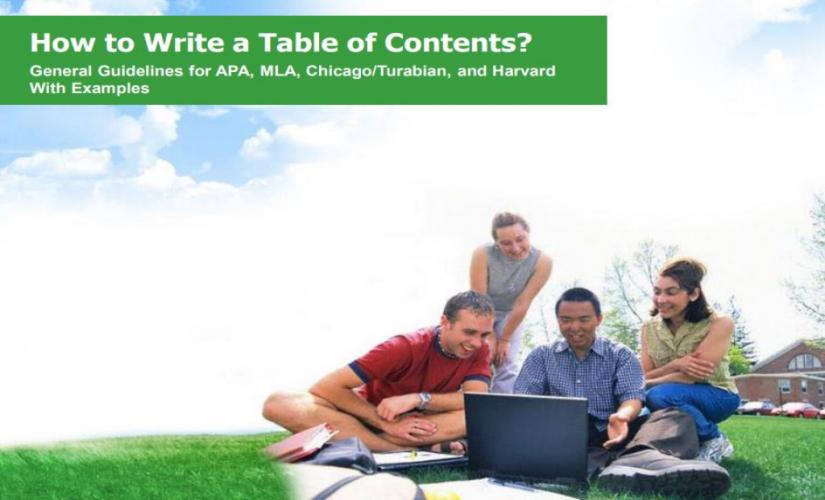
Difference Between a Table of Contents and an Outline
In essence, a TOC is a description of first-level headings (topics) and second-level headings (subtopics) within the paper’s body. For a longer document, writers may also include third-level titles to make the text palatable to read. Ideally, the length of papers determines the depth that authors go into detailing their writing in TOCs. Basically, this feature means that shorter texts may not require third-level headings. In contrast, an essay outline is a summary of the paper’s main ideas with a hierarchical or logical structuring of the content. Unlike a TOC that only lists headings and subheadings, outlines capture these headings and then describe the content briefly under each one. As such, an outline provides a more in-depth summary of essay papers compared to a TOC.
How to Write a Table of Contents in APA
When writing a TOC in the APA format, writers should capture all the headings in the paper – first-level, second-level, and even third-level. Besides this information, they should also include an abstract, references, and appendices. Notably, while a TOC in the APA style has an abstract, this section is not necessary for the other formats, like MLA, Chicago/Turabian, and Harvard. Hence, an example of a Table of Contents written in the APA format is indicated below:
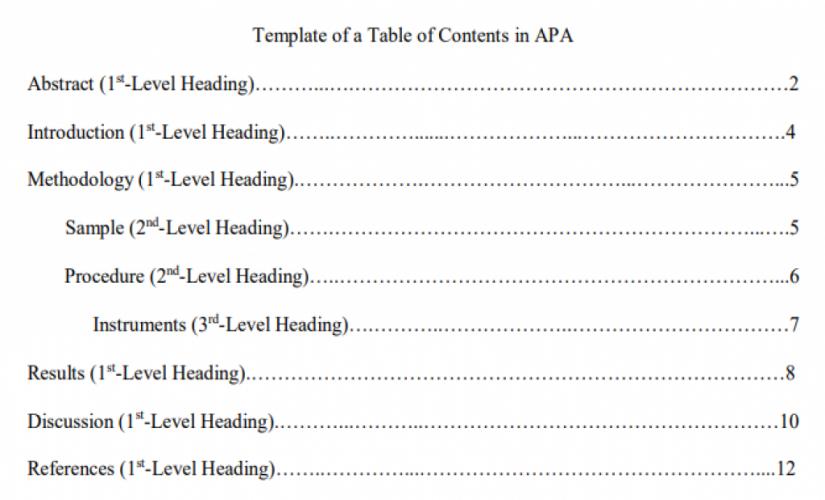
How to Write a Table of Contents in MLA
Unlike papers written in the APA style, MLA papers do not require a Table of Contents unless they are long enough. In this case, documents, like theses, dissertations, and books written in the MLA format should have a TOC. Even where a TOC is necessary, there is no specific method that a writer should use when writing it. In turn, the structure of the TOC is left to the writer’s discretion. However, when students have to include a TOC in their papers, the information they capture should be much more than what would appear in the APA paper. Hence, an example of writing a Table of Contents in MLA format is:
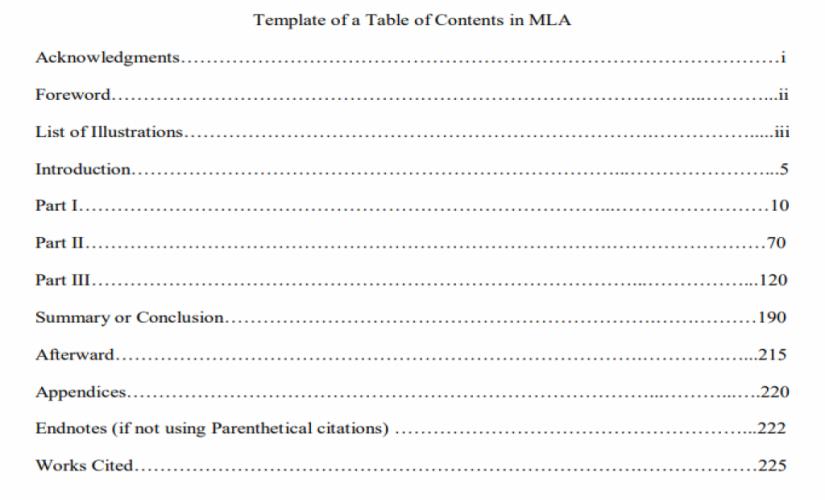
In the case of writing a research paper, an example of a Table of Contents should be:
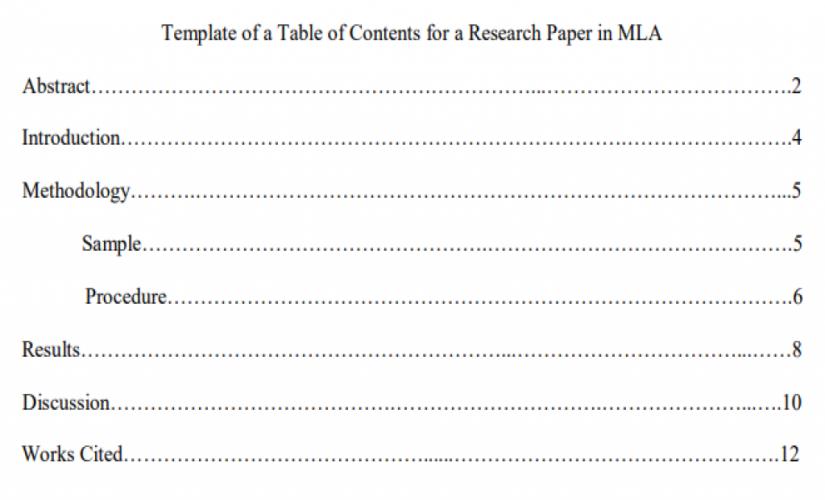
How to Write a Table of Contents in Chicago/Turabian
Like the MLA style, a Chicago/Turabian paper does not require writing a Table of Contents unless it is long enough. When a TOC is necessary, writers should capitalize on major headings. Additionally, authors do not need to add a row of periods (. . . . . . . .) between the heading entry and the page number. Moreover, the arrangement of the content should start with the first-level heading, then the second-level heading, and, finally, the third-level title, just like in the APA paper. In turn, all the information that precedes the introduction part should have lowercase Roman numerals. Also, the row of periods is only used for major headings. Hence, an example of writing a Table of Contents in a Chicago/Turabian paper is:
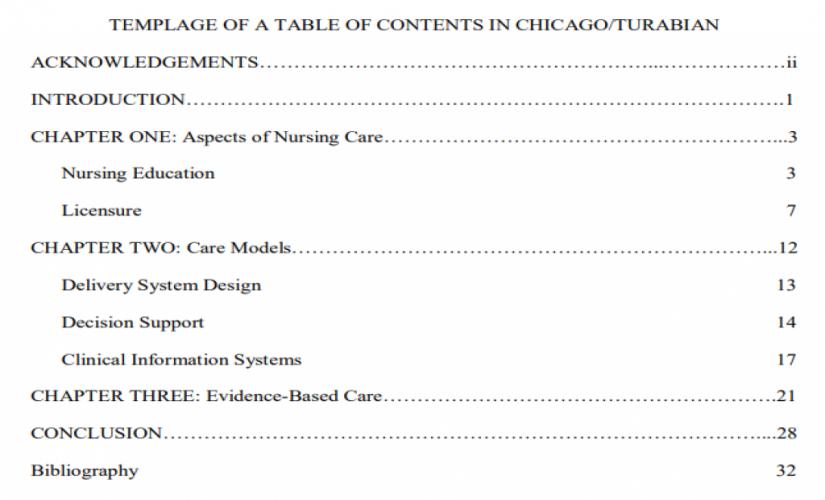
How to Write a Table of Contents in Harvard
Like in the other formats, writing a Table of Contents in the Harvard style is captured by having the title “Table of Contents” at the center of the page, in the first line. Basically, it comes after the title page and captures all the sections and subsections of Harvard papers. In other words, writers must indicate first-level headings in a numbered list. Also, scholars should align titles to the left side and capitalize them. In turn, if there is a need to show second-level headings, authors should list them under corresponding first-level headings by using bullet points. However, it is essential for students not to disrupt the numbering of first-level headings. Moreover, writers should align second-level headings to the left side and indent them by half an inch and capitalize on this content. Hence, an example of writing a Table of Contents in a Harvard paper should appear as below:
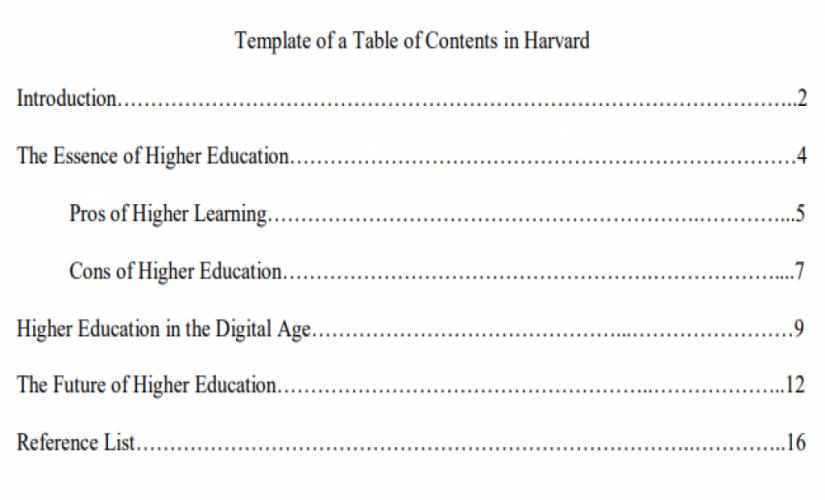
A Table of Content (TOC) is an essential component of an academic paper, particularly for long documents, like theses, dissertations, and research papers. When students are writing a TOC, they should be careful to follow the applicable format’s rules and standards. Regardless of the format, writers should master the following tips when writing a TOC:
- Write the TOC on a new page after the title page.
- Indicate first-level headings of the document in a numbered list.
- Indicate second-level headings under the corresponding first-level heading.
- If applicable, indicate third-level headings under the corresponding second-level heading.
- Write the page number for each heading.
- Put the content in a two-column table.
- Title the page with “Table of Contents.”
To Learn More, Read Relevant Articles
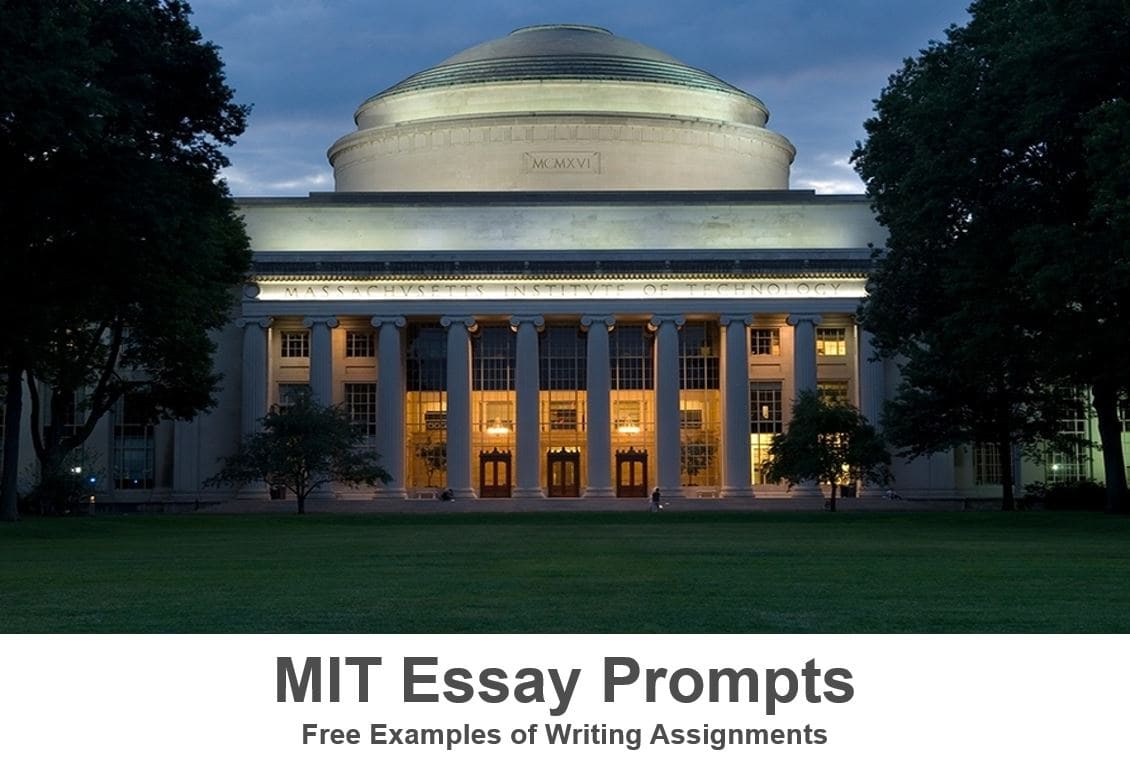
MIT Essay Prompts: Free Examples of Writing Assignments in 2024
- Icon Calendar 26 August 2020
- Icon Page 2576 words
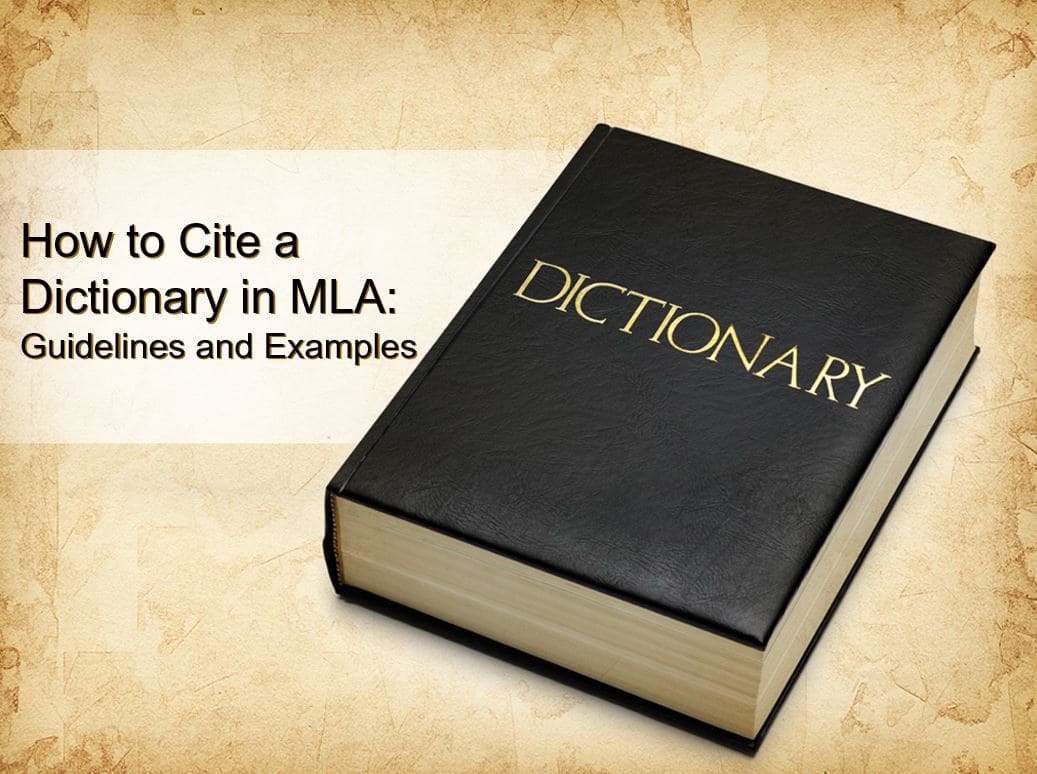
How to Cite a Dictionary in MLA 9: Guidelines and Examples
- Icon Calendar 24 August 2020
- Icon Page 1342 words
Have a language expert improve your writing
Run a free plagiarism check in 10 minutes, automatically generate references for free.
- Knowledge Base
- Dissertation
- Dissertation Table of Contents in Word | Instructions & Examples
Dissertation Table of Contents in Word | Instructions & Examples
Published on 15 May 2022 by Tegan George .
The table of contents is where you list the chapters and major sections of your thesis, dissertation, or research paper, alongside their page numbers. A clear and well-formatted table of contents is essential, as it demonstrates to your reader that a quality paper will follow.
The table of contents (TOC) should be placed between the abstract and the introduction. The maximum length should be two pages. Depending on the nature of your thesis, dissertation, or paper, there are a few formatting options you can choose from.
Download Word doc Download Google doc
Instantly correct all language mistakes in your text
Be assured that you'll submit flawless writing. Upload your document to correct all your mistakes.

Table of contents
What to include in your table of contents, what not to include in your table of contents, creating a table of contents in microsoft word, table of contents examples, updating a table of contents in microsoft word, other lists in your thesis, dissertation, or research paper, frequently asked questions about the table of contents.
Depending on the length of your document, you can choose between a single-level, subdivided, or multi-level table of contents.
- A single-level table of contents only includes ‘level 1’ headings, or chapters. This is the simplest option, but it may be too broad for a long document like a dissertation.
- A subdivided table of contents includes chapters as well as ‘level 2’ headings, or sections. These show your reader what each chapter contains.
- A multi-level table of contents also further divides sections into ‘level 3’ headings. This option can get messy quickly, so proceed with caution. Remember your table of contents should not be longer than 2 pages. A multi-level table is often a good choice for a shorter document like a research paper.
Examples of level 1 headings are Introduction, Literature Review, Methodology, and Bibliography. Subsections of each of these would be level 2 headings, further describing the contents of each chapter or large section. Any further subsections would be level 3.
In these introductory sections, less is often more. As you decide which sections to include, narrow it down to only the most essential.
Including appendices and tables
You should include all appendices in your table of contents. Whether or not you include tables and figures depends largely on how many there are in your document.
If there are more than three figures and tables, you might consider listing them on a separate page. Otherwise, you can include each one in the table of contents.
- Theses and dissertations often have a separate list of figures and tables.
- Research papers generally don’t have a separate list of figures and tables.
The only proofreading tool specialized in correcting academic writing
The academic proofreading tool has been trained on 1000s of academic texts and by native English editors. Making it the most accurate and reliable proofreading tool for students.

Correct my document today
All level 1 and level 2 headings should be included in your table of contents, with level 3 headings used very sparingly.
The following things should never be included in a table of contents:
- Your acknowledgements page
- Your abstract
- The table of contents itself
The acknowledgements and abstract always precede the table of contents, so there’s no need to include them. This goes for any sections that precede the table of contents.
To automatically insert a table of contents in Microsoft Word, be sure to first apply the correct heading styles throughout the document, as shown below.
- Choose which headings are heading 1 and which are heading 2 (or 3!
- For example, if all level 1 headings should be Times New Roman, 12-point font, and bold, add this formatting to the first level 1 heading.
- Highlight the level 1 heading.
- Right-click the style that says ‘Heading 1’.
- Select ‘Update Heading 1 to Match Selection’.
- Allocate the formatting for each heading throughout your document by highlighting the heading in question and clicking the style you wish to apply.
Once that’s all set, follow these steps:
- Add a title to your table of contents. Be sure to check if your citation style or university has guidelines for this.
- Place your cursor where you would like your table of contents to go.
- In the ‘References’ section at the top, locate the Table of Contents group.
- Here, you can select which levels of headings you would like to include. You can also make manual adjustments to each level by clicking the Modify button.
- When you are ready to insert the table of contents, click ‘OK’ and it will be automatically generated, as shown below.
The key features of a table of contents are:
- Clear headings and subheadings
- Corresponding page numbers
Check with your educational institution to see if they have any specific formatting or design requirements.
Write yourself a reminder to update your table of contents as one of your final tasks before submitting your dissertation or paper. It’s normal for your text to shift a bit as you input your final edits, and it’s crucial that your page numbers correspond correctly.
It’s easy to update your page numbers automatically in Microsoft Word. Simply right-click the table of contents and select ‘Update Field’. You can choose either to update page numbers only or to update all information in your table of contents.
In addition to a table of contents, you might also want to include a list of figures and tables, a list of abbreviations and a glossary in your thesis or dissertation. You can use the following guides to do so:
- List of figures and tables
- List of abbreviations
It is less common to include these lists in a research paper.
All level 1 and 2 headings should be included in your table of contents . That means the titles of your chapters and the main sections within them.
The contents should also include all appendices and the lists of tables and figures, if applicable, as well as your reference list .
Do not include the acknowledgements or abstract in the table of contents.
To automatically insert a table of contents in Microsoft Word, follow these steps:
- Apply heading styles throughout the document.
- In the references section in the ribbon, locate the Table of Contents group.
- Click the arrow next to the Table of Contents icon and select Custom Table of Contents.
- Select which levels of headings you would like to include in the table of contents.
Make sure to update your table of contents if you move text or change headings. To update, simply right click and select Update Field.
The table of contents in a thesis or dissertation always goes between your abstract and your introduction.
Cite this Scribbr article
If you want to cite this source, you can copy and paste the citation or click the ‘Cite this Scribbr article’ button to automatically add the citation to our free Reference Generator.
George, T. (2022, May 15). Dissertation Table of Contents in Word | Instructions & Examples. Scribbr. Retrieved 3 June 2024, from https://www.scribbr.co.uk/thesis-dissertation/contents-page/
Is this article helpful?
Tegan George
Other students also liked, dissertation title page, how to write an abstract | steps & examples, thesis & dissertation acknowledgements | tips & examples.
- Discoveries
- Right Journal
- Journal Metrics
- Journal Fit
- Abbreviation
- In-Text Citations
- Bibliographies
- Writing an Article
- Peer Review Types
- Acknowledgements
- Withdrawing a Paper
- Form Letter
- ISO, ANSI, CFR
- Google Scholar
- Journal Manuscript Editing
- Research Manuscript Editing
Book Editing
- Manuscript Editing Services
Medical Editing
- Bioscience Editing
- Physical Science Editing
- PhD Thesis Editing Services
- PhD Editing
- Master’s Proofreading
- Bachelor’s Editing
- Dissertation Proofreading Services
- Best Dissertation Proofreaders
- Masters Dissertation Proofreading
- PhD Proofreaders
- Proofreading PhD Thesis Price
- Journal Article Editing
- Book Editing Service
- Editing and Proofreading Services
- Research Paper Editing
- Medical Manuscript Editing
- Academic Editing
- Social Sciences Editing
- Academic Proofreading
- PhD Theses Editing
- Dissertation Proofreading
- Proofreading Rates UK
- Medical Proofreading
- PhD Proofreading Services UK
- Academic Proofreading Services UK
Medical Editing Services
- Life Science Editing
- Biomedical Editing
- Environmental Science Editing
- Pharmaceutical Science Editing
- Economics Editing
- Psychology Editing
- Sociology Editing
- Archaeology Editing
- History Paper Editing
- Anthropology Editing
- Law Paper Editing
- Engineering Paper Editing
- Technical Paper Editing
- Philosophy Editing
- PhD Dissertation Proofreading
- Lektorat Englisch
- Akademisches Lektorat
- Lektorat Englisch Preise
- Wissenschaftliches Lektorat
- Lektorat Doktorarbeit
PhD Thesis Editing
- Thesis Proofreading Services
- PhD Thesis Proofreading
- Proofreading Thesis Cost
- Proofreading Thesis
- Thesis Editing Services
- Professional Thesis Editing
- Thesis Editing Cost
- Proofreading Dissertation
- Dissertation Proofreading Cost
- Dissertation Proofreader
- Correção de Artigos Científicos
- Correção de Trabalhos Academicos
- Serviços de Correção de Inglês
- Correção de Dissertação
- Correção de Textos Precos
- 定額 ネイティブチェック
- Copy Editing
- FREE Courses
- Revision en Ingles
- Revision de Textos en Ingles
- Revision de Tesis
- Revision Medica en Ingles
- Revision de Tesis Precio
- Revisão de Artigos Científicos
- Revisão de Trabalhos Academicos
- Serviços de Revisão de Inglês
- Revisão de Dissertação
- Revisão de Textos Precos
- Corrección de Textos en Ingles
- Corrección de Tesis
- Corrección de Tesis Precio
- Corrección Medica en Ingles
- Corrector ingles
Select Page
How To Write a Table of Contents for Academic Papers
Posted by Rene Tetzner | Mar 17, 2021 | How To Get Published | 0 |

How To Write a Table of Contents for Academic Papers Although every author begins a writing project with the best of intentions and an ideal outline in mind, it often proves difficult to stick to one’s initial plans as the text begins to unfold and its complexities grow in number and depth. Sometimes a document quickly exceeds the word limits for a project, and at others certain important aspects are neglected or turn out a good deal shorter than intended. Drafting a working table of contents for your writing project can provide an excellent tool for keeping your discussion on track and your text within length requirements as you write.
A working table of contents should begin with a title. This title may change as you draft your text, but a working title will help you focus your thoughts as you devise the headings and plan the content for the main parts, chapters, sections and subsections that should be added beneath it. All headings, whether numbered or not, should be formatted in effective and consistent ways that distinguish section levels and clearly indicate the overall structure of the text. These headings can also be altered as your writing advances, but they will provide an effective outline of what you need to discuss and the order in which you think the main topics should be presented. At this initial stage, it is also a good idea to write under each heading a brief summary of or rough notes about what you hope to include in that part of the document, and you can continue to add, adjust and move material around within and among the sections as your table of contents and ultimately your text progresses. Reminders of how long (measured in words, paragraphs or pages) the entire text and each of its parts should ideally be may also prove helpful.

Once you have your annotated table of contents drafted, it will serve as an informative list of both content and order that can be productively consulted as you write. Assuming you construct your working table of contents as a computer file in the same program you intend to use for writing the entire document, you can also use the table of contents as a template for composing the text as a whole, replacing your rough notes under each heading with the formal text as you draft it. This practice lends an immediate physical presence to the guidance provided by your table of contents because you are literally working within that outline, which can be especially wise if you tend to run on or become distracted by new ideas as you write.
Finally, your working table of contents can become your final table of contents if one is required for your project. If you would like to use the working table of contents in this way and are also using it as a template, be sure to rename the file and save a separate copy before you begin adding the formal text of your document. Then you can simply delete your summaries and rough notes from the original table of contents to make your final one, leaving only the headings, to which you can add relevant page numbers as required.

You might be interested in Services offered by Proof-Reading-Service.com
Journal editing.
Journal article editing services
PhD thesis editing services
Scientific Editing
Manuscript editing.
Manuscript editing services
Expert Editing
Expert editing for all papers
Research Editing
Research paper editing services
Professional book editing services
Related Posts

Choosing the Right Journal
September 10, 2021

Example of a Quantitative Research Paper
September 4, 2021

What Is a Good H-Index Required for an Academic Position?
September 3, 2021

Acknowledgements Example for an Academic Research Paper
September 1, 2021
Our Recent Posts

Our review ratings
- Examples of Research Paper Topics in Different Study Areas Score: 98%
- Dealing with Language Problems – Journal Editor’s Feedback Score: 95%
- Making Good Use of a Professional Proofreader Score: 92%
- How To Format Your Journal Paper Using Published Articles Score: 95%
- Journal Rejection as Inspiration for a New Perspective Score: 95%
Explore our Categories
- Abbreviation in Academic Writing (4)
- Career Advice for Academics (5)
- Dealing with Paper Rejection (11)
- Grammar in Academic Writing (5)
- Help with Peer Review (7)
- How To Get Published (146)
- Paper Writing Advice (17)
- Referencing & Bibliographies (16)

Check Your Paper for Plagiarism within 10 minutes
Start Plagiarism Software
Online Editing & Proofreading for Students
Get it proofread now
Online Printing & Binding Services for Students
Configure binding now
- Academic essay overview
- The writing process
- Structuring academic essays
- Types of academic essays
- Academic writing overview
- Sentence structure
- Academic writing process
- Improving your academic writing
- Titles and headings
- APA style overview
- APA citation & referencing
- APA structure & sections
- Citation & referencing
- Structure and sections
- APA examples overview
- Commonly used citations
- Other examples
- British English vs. American English
- Chicago style overview
- Chicago citation & referencing
- Chicago structure & sections
- Chicago style examples
- Citing sources overview
- Citation format
- Citation examples
- College essay overview
- Application
- How to write a college essay
- Types of college essays
- Commonly confused words
- Definitions
- Dissertation overview
- Dissertation structure & sections
- Dissertation writing process
- autumnacies
- Graduate school overview
- Application & admission
- Study abroad
- Harvard referencing overview
- Language rules overview
- Grammatical rules & structures
- Parts of speech
- Punctuation
- Methodology overview
- analysing data
- Experiments
- Observations
- Inductive vs. Deductive
- Qualitative vs. Quantitative
- Types of validity
- Types of reliability
- Sampling methods
- Theories & Concepts
- Types of research studies
- Types of variables
- MLA style overview
- MLA examples
- MLA citation & referencing
- MLA structure & sections
- Plagiarism overview
- Plagiarism chequeer
- Types of plagiarism
- Printing production overview
- Research bias overview
- Types of research bias
- Research paper structure & sections
- Types of research papers
- Research process overview
- Problem statement
- Research proposal
- Research topic
- Statistics overview
- Levels of measurment
- Measures of central tendency
- Measures of variability
- Hypothesis testing
- Parameters & test statistics
- Types of distributions
- Correlation
- Effect size
- Hypothesis testing assumptions
- Types of ANOVAs
- Types of chi-square
- Statistical data
- Statistical models
- Spelling mistakes
- Tips overview
- Academic writing tips
- Dissertation tips
- Sources tips
- Working with sources overview
- Evaluating sources
- Finding sources
- Including sources
- Types of sources
Your Step to Success
Printing & Binding for Students in Canada
Example for Table of Contents
How do you like this article cancel reply.
Save my name, email, and website in this browser for the next time I comment.

Inhaltsverzeichnis
- 1 Definition
- 3 Examples for Your Thesis
- 4 Master’s Thesis Examples
- 5 Microsoft Word Tutorial
- 6 In a Nutshell
Definition
A table of contents example will help structure a long academic manuscript and a table of contents page is necessary for academic submission. The table of contents contains an organised listing of your manuscript’s chapters and sections with clearly marked (and accurate) page numbers. The aim of the table of contents is to allow the reader to flip easily to the section they require and to get a feel of your argument’s structure.
What comes first, table of contents or abstract?
If you are writing an academic paper, you have to take the order of your paper into account. Usually, the first sections of your thesis are the title page, cover page, acknowledgements and the abstract . After these pages, you place the table of contents. Be sure to cheque that all of the page numbers in your table of contents are correct.
What variations of table of content examples exist?
The table of contents can be displayed in the following formats:
- Single level table of contents
- Subdivided table of contents
- Multi-level table of contents
- Academic table of contents
You will find further details about what needs to be included inside of the table of contents on our blog.
Are references included in table of contents?
Yes. The references are included in the table of contents. You add them in as you would any other section of your thesis. Simply write the section in the table of contents with the corresponding page number. However, the acknowledgement for thesis and the abstract are usually not included in the table of contents. However, cheque with your institution as this could be dependent upon the formatting that you’re required to follow.
How can I make a table of contents in Microsoft Word?
On Microsoft Word, you will find the function to create a table of contents under the ‘references’ tab. Click on the tab and select ‘table of contents’. You can use one that has been designed by Microsoft Word, or you can create a custom one by yourself. Scroll down for a full tutorial on Microsoft Word and creating a table of contents.
Examples for Your Thesis
Below, you will find different examples for table of contents, including a
- Single level table of contents example
- Subdivided table of contents example
- Multi-level table of contents example
We will also show you with an example how the table of contents for a bachelor’s thesis could look like, as well as for a master’s thesis.
Advice for creating a good table of contents: A good table of contents must be easy to read and formatted accurately, containing quick reference pages for all figures and illustrations. A table of contents example will help you structure your own thesis, but remember to make it relevant to your discipline. Table of contents example structures can be created for different disciplines, such as social sciences, humanities and engineering.
The type and length of a table of contents example will depend on the manuscript. Some thesis’ are short, containing just several chapters, whilst others (like a PhD thesis) are as lengthy as a book. This length will dictate the amount of detail that goes into forming a table of contents example page and the amount of “levels” (or subdivisions) in each chapter.
- ✓ Post a picture on Instagram
- ✓ Get the most likes on your picture
- ✓ Receive up to CAN$400 cash back
Single Level Table of Contents Example
For shorter documents, a single level table of contents example can be used. This is a short and succinct table of contents example which utilises only single-level entries on sections or chapters. Remember, you’ll need to include properly formatted dots to lead the reader’s eye to the page number on the far right. The following table of contents example explores this basic structure:
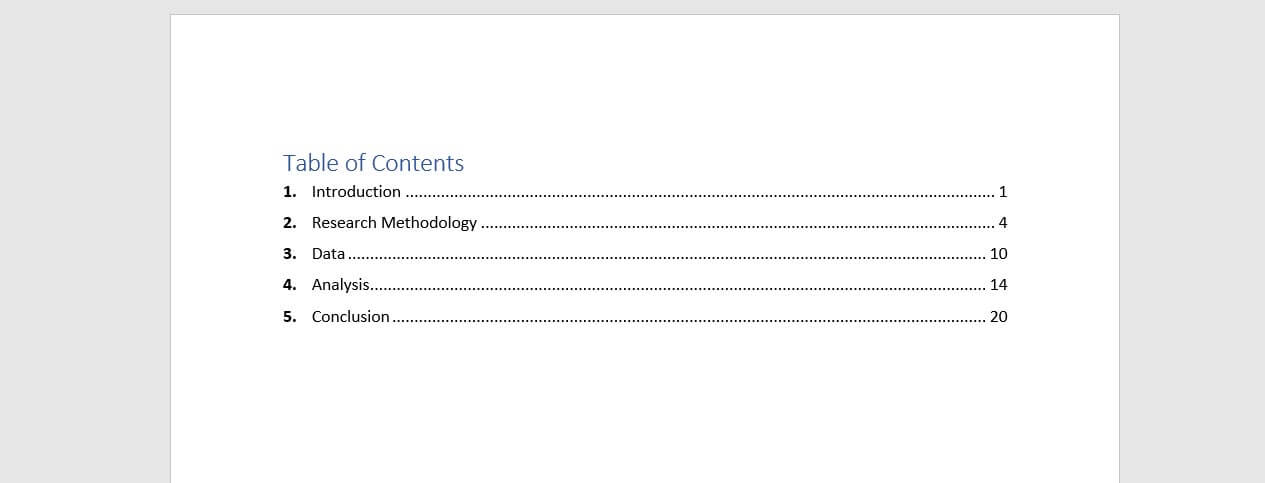

Subdivided Table of Contents E xample
A subdivided table of contents example is required for more lengthy papers, offering a subdivision of chapters and sections within chapters. These are more detailed and are recommended for higher-level dissertations like masters or PhD thesis’ (as well as some more detailed bachelor’s dissertations).
When formating subdivided table of contents example, ensure that chapters are listed in bold font and that subsections are not. It’s common (though not necessary) to denote each subsection by a number (1.1, etc.). You’ll also want to indent the subsections so that they can be read easily. The following table of contents example explores this structure:
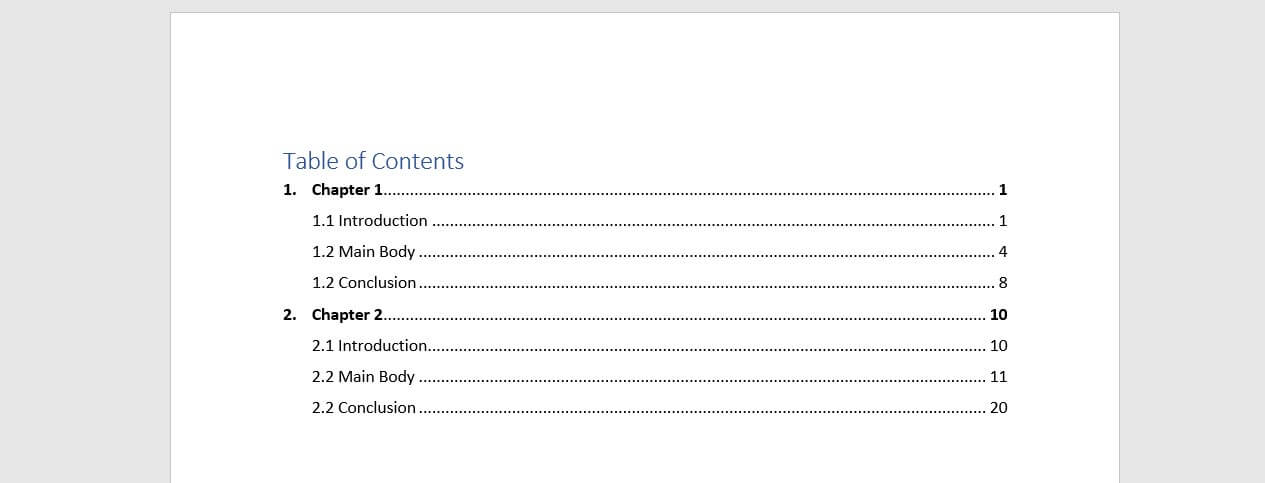
Multi-level Table of Contents E xample
Adding additional levels to your table of contents is known as a multi-level table of contents example. These would be numbered onwards at 1.1.1, etc. Be aware that although you want to guide your reader through your manuscript, you should only highlight important areas of your manuscript, like sections and sub-sections, rather than random areas or thoughts in your manuscript. Creating too many levels will make your table of contents unnecessarily busy and too complex.
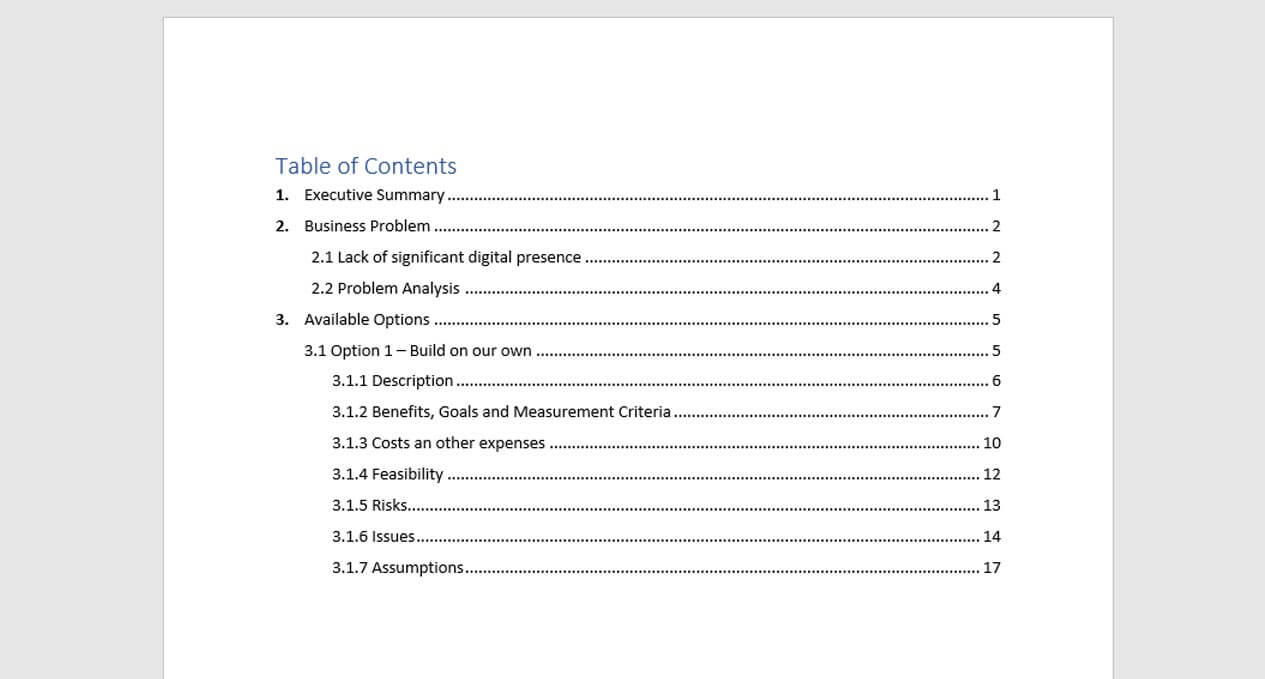
Academic Table of Contents
All of the above can be used as an academic table of contents example. Often, each separate heading in an academic work needs to be both numbered and labelled in accordance with your preferred reference style (consult your department). The following table of contents example sections will illustrate a table of contents example for a bachelor thesis and a table of contents example for a master thesis.
Table of Contents Example: Bachelor’s Thesis
A bachelor’s degree thesis has no set word or page limit nationwide and will depend entirely on your university or department’s guidelines. However, you can expect a thesis under 60 pages of length at between 10,000 – 15,000 words. As such, you won’t be expected to produce a long and detailed table of contents example with multiple levels and subsections. This is because your main body is more limited in terms of word count. At most, you may find yourself using a subdivided table of contents similar to the table of contents example above.
A bachelor’s thesis table of contents example may be structured like so:
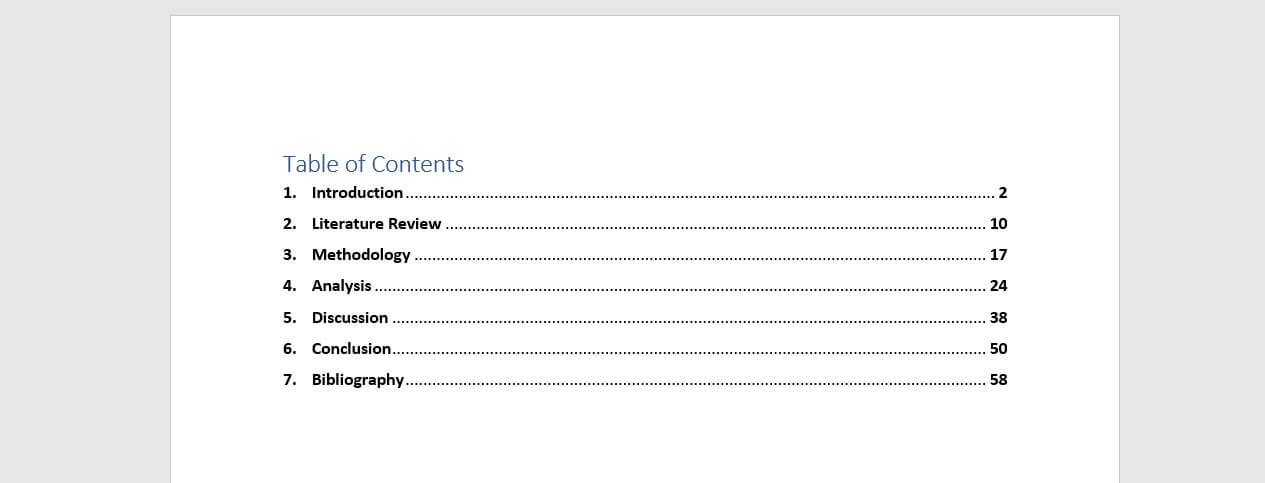
This table of contents example may change depending on your discipline and thesis structure, but note that a single-level structure will often suffice. Subdivided structures like the table of contents example listed earlier will only be necessary when writing several chapters, like in a Master’s thesis.
Master’s Thesis Examples
A master’s table of contents example is more complex than a bachelor’s thesis. This is because they average at about 80 pages with up to 40,000 words. Because this work is produced at a higher academic level, it normally includes a subdivision of chapters and subheadings, with a separate introduction and conclusion, as well as an abstract.
A table of contents example for a master’s thesis may then look something like this:
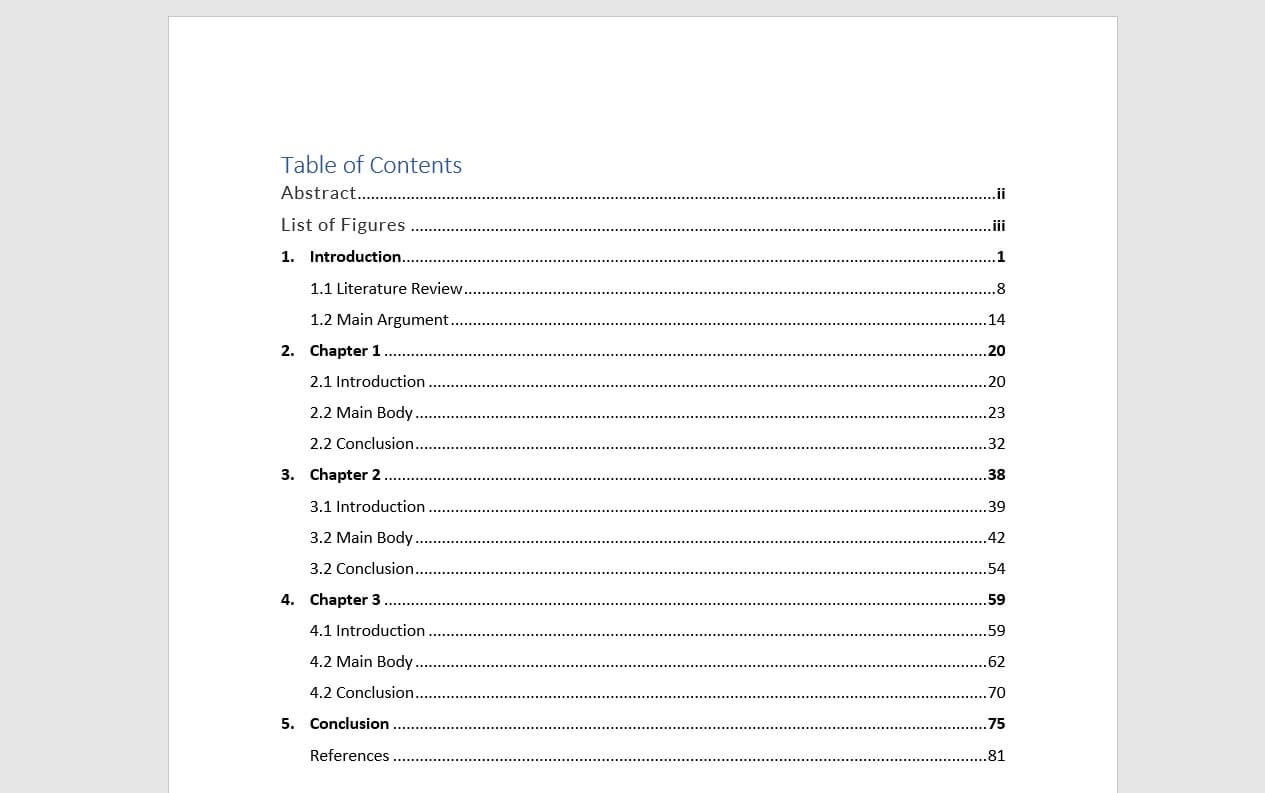
Microsoft Word Tutorial
Creating a table of contents page with Microsoft Word is simple.
In a Nutshell
- All theses are different. Various departments and disciplines follow different structures and rules. The table of contents example pages here will help you in general to format your document, but remember to consult your university guidelines
- Consistency and accuracy are the most important things to remember. You need the correct page number and the same layout for each chapter. It’s no good combining single-level table of contents with a multi-level table of contents
- Simply put, bachelor’s thesis’ generally follow a single-level table of contents example unless otherwise specified
- Postgraduate thesis’ like master and PhD-level work generally require a more detailed subdivision table of contents example. This is because they deal with both more complex arguments and more words
- Remember to include all aspects of your thesis within the table of contents. Pre-thesis material needs to be listed in Roman numerals and you need to include all back-matter as well, such as References and Bibliography
We use cookies on our website. Some of them are essential, while others help us to improve this website and your experience.
- External Media
Individual Privacy Preferences
Cookie Details Privacy Policy Imprint
Here you will find an overview of all cookies used. You can give your consent to whole categories or display further information and select certain cookies.
Accept all Save
Essential cookies enable basic functions and are necessary for the proper function of the website.
Show Cookie Information Hide Cookie Information
Statistics cookies collect information anonymously. This information helps us to understand how our visitors use our website.
Content from video platforms and social media platforms is blocked by default. If External Media cookies are accepted, access to those contents no longer requires manual consent.
Privacy Policy Imprint

Want to create or adapt books like this? Learn more about how Pressbooks supports open publishing practices.
TABLE OF CONTENTS
Module i: academic reading and analysis skills, chapter 1: the value of communications courses.
- Communications and Job Readiness
- Communication Skills that Employers Want
- What Professors Want
CHAPTER 2: uNDERSTANDING ASSIGNMENT OUTLINES AND INSTRUCTIONS
- How Professors Design Assignments
- Understanding Assignment Verbs
- Asking the Right Questions
- Reading and Interpreting Rubrics
- Critical Thinking Skills
CHAPTER 3: CRITICAL READING STRATEGIES
- High School vs. Post-Secondary Expectations
- Setting Goals
- Reading Strategies
- Four Ways of Reading
- SQ3R Strategy
CHAPTER 4: EFFECTIVE STUDY HABITS
- Understand Your Learning Style
- Time Management
- Note-Taking
- Summarizing
- Online Study Tools
- Academic Support Resources
chapter 5: audience & purpose of writing
- Types of Paragraphs
- The Writing Process
CHAPTER 6: BIAS IN WRITING AND RESEARCH
- Style and Tone
- Opposing Ideas and Limits of Arguments
- Hidden Agendas
- Fact vs. Opinion
- The Use of “I”
- Incorporating Visual Elements
CHAPTER 7: CREDIBLE RESEARCH SOURCES
- Primary vs. Secondary Sources
- Popular (Professional) vs. Scholarly (Academic) Sources
- Electronic Resources
- Efficient Searches
- Google Scholar
- Print Resources
- Reliability
- Credibility
- Managing Sources
- Sheridan’s Library Services
CHAPTER 8: DEVELOPING MEDIA LITERACY AND AWARENESS
- Alternative facts
- Native advertising
- Social engineering
- Analyzing Visual Media & Visual Rhetoric
MODULE ii: ACADEMIC WRITING SKILLS
Chapter 9: research topics, questions, and thesis statements.
- Research Topics
- Research Questions
- Characteristics of
- Three-Story Thesis Model
- Reevaluating
CHAPTER 10: ESSAY OUTLINING
- The 5-Paragraph Essay Model
- Organizing thoughts
- Order and Purpose
- Writing Outlines
- That Supports the Thesis
- That Connects Sources
CHAPTER 11: WRITING ACADEMIC PARAGRAPHS, INCORPORATING SOURCES AS EVIDENCE, & APA REFERENCING
- How to write
- Introducing
- In-Text Citations
- Summaries & Paraphrases
- Reference Pages
- Avoiding Plagiarism
- Academic Integrity
chapter 12: writing introductions & conclusions
- Introduction Writing Strategies
- Conclusion Writing Strategies
CHAPTER 13: EXPOSITORY (INFORMATIVE) ESSAYS
- What is an Expository Essay?
- Difference between Expository and Persuasive Essays
CHAPTER 14: ARGUMENTATIVE (PERSUASIVE) ESSAYS
- What is an Argumentative Essay?
- Arguing vs. Argument
- Language Use
- Acknowledging Other Positions
- Limits to Your Argument
CHAPTER 15: EDITING AND rEVISING STRATEGIES
- Strategies & Tools for
MODULE iii: ACADEMIC SURVIVAL SKILLS
Chapter 16: how to ‘student,’ or setting yourself up for success in college.
- Coping with Workload Stress
- Form of address
- Sending an email
- Asking for help
- Asking for letters of reference
- Building a relationship
- Dealing with Disappointing Feedback & Grades on Assignments
- Strategies for
chapter 17: presentation skills
- Glossophobia and Anxiety
- Engaging Your Audience
- Giving Online Presentations
MODULE IV: SUPPLEMENTARY READINGS
- Section Overview
- Newspaper Article: From Gander to Broadway: The Journey of ‘Come From Away’
- Newspaper Article: Sheridan Grad Wins Oscar for “Bao”
- Newspaper Opinion Editorial (OpEd): Steve Irwin Inspired Generations of Environmentalists
- Newspaper Review: Kenzo Ramen is Noodle Soup for the Soul
- Professional Report: Halton Region youth in/at risk research report
- Professional Article: Cause Hackathon as Experiential Learning
- Academic Case Study: The Intersectional Oppressions of South Asian Immigrant Women and Vulnerability in Relation to Domestic Violence: A Case Study
- Academic Article: The New Visual Testimonial: Narrative, Authenticity, and Subjectivity in Emerging Commercial Photographic Practice
- Academic Article: Immigrant Mental Health, a Public Health Issue: Looking Back and Moving Forward
- Academic Research Study: Vitamin D Status of Older Adults of Diverse Ancestry Living in the Greater Toronto Area
Writing for Academic and Professional Contexts: An Introduction Copyright © 2023 by Sheridan College is licensed under a Creative Commons Attribution-NonCommercial-ShareAlike 4.0 International License , except where otherwise noted.
Share This Book

Reports and essays: key differences

Know what to expect
Explore the main differences between reports and essays and how to write for your assignments
You'll complete assignments with different requirements throughout your degree, so it's important to understand what you need to do for each of them. Here we explore the key differences between reports and essays.
This page describes general features of academic reports and essays. Depending on your subject you may use all of these features, a selection of them, or you may have additional requirements.
There is no single right way to write a report or essay, but they are different assignments. At a glance:
- Reports depend heavily on your subject and the type of report.
- Essays usually have specific content and a planned structure with a focus on sense and flow. You subject might need different types of information in your introduction – some disciplines include a short background and context here, while others begin their discussion, discuss their resources or briefly signpost the topic.
Differences between reports and essays
This table compares reports and essays and provides an outline of the standard structure for each. Your assignment will also depend on your discipline, the purpose of your work, and your audience – so you should check what you need to do in your course and module handbooks, instructions from your lecturer, and your subject conventions.
Table adapted from Cottrell, 2003, p. 209.
The structure of reports
Most reports use an IMRaD structure: Introduction, Methods, Results and Discussion.
Below are some common sections that also appear in reports. Some sections include alternative headings.
1. Table of contents
Your contents shows the number of each report section, its title, page number and any sub-sections. Sub-section numbers and details start under the section title, not the margin or the number.
2. Abstract or Executive summary
This brief summary of the report is usually the last thing you write.
3. Introduction
Your introduction describes the purpose of the report, explains why it necessary or useful, and sets out its precise aims and objectives.
4. Literature review
This describes current research and thinking about the problem or research question, and is often incorporated into the introduction.
5. Methods or Methodology
This describes and justifies the methods or processes used to collect your data.
6. Results or Findings
This section presents the results (or processed data) from the research and may consist of mainly tables, charts and or diagrams.
7. Discussion, or Analysis, or Interpretation
This section analyses the results and evaluates the research carried out.
8. Conclusion
The conclusion summarises the report and usually revisits the aims and objectives.
9. Recommendations
In this section the writer uses the results and conclusions from the report to make practical suggestions about a problem or issue. This may not be required.
10. Appendices
You can include raw data or materials that your report refers to in the appendix, if you need to. The data is often presented as charts, diagrams and tables. Each item should be numbered : for example, write Table 1 and its title; Table 2 and its title, and so on as needed.
Structure of essays
Introduction.
Your essay introduction contextualises and gives background information about the topic or questions being discussed, and sets out what the essay is going to cover.
Your essay body is divided into paragraphs. These paragraphs help make a continuous, flowing text.
The conclusion summarises the main points made in the essay. Avoid introducing new information in your conclusion.
Bibliography or Reference list
This is a list of the resources you've used in your essay. This is usually presented alphabetically by authors’ surname.
Reference for the Table of Distinctions above:
Cottrell, S. (2003). The Study Skills Handbook (2nd ed.). Basingstoke: Palgrave.
Download our report and essay differences revision sheet
Download this page as a PDF for your report and essay revision notes.

Key features of academic reports

Basic essay structure

Writing clear sentences
Find an undergraduate or postgraduate degree course that suits you at Portsmouth.

Guidance and support
Find out about the guidance and support you'll get if you need a helping hand with academic life – or life in general – when you study with us at Portsmouth.

- Our Process

Table of Contents for a Dissertation or Thesis with Examples
Published by Ellie Cross at February 16th, 2023 , Revised On February 1, 2024
An organised list of the chapters, sections, and subsections that help the reader navigate through your dissertation or thesis is called the table of content . For the reader to jump to any part or section of their interest, the structure and the sections should clearly be labelled with the correct page numbers.
All of the main headings, subheadings, and figures have to be added to the table of content to ensure complete correctness. A good table of contents should be easy to read, properly formatted, and finalised. While it can be created manually, Microsoft Word, however, also has an automatic formatting feature.
While doing the final touchups to your dissertation , the table of contents is one of the most important components to add to it. It aids the reader in navigating (much like a map) through your thesis and key points.
What to add and what to avoid adding to a table of contents are going to be discussed in this article to assist you in mapping your dissertation properly.
What Should be included in the Table of Content?
The length of your document should be the determining factor before choosing a single-level, subdivided, or multi-level table of contents.
Single-level TOC
If you have decided to go for a single-level table of content, only include “level 1” headers, such as chapters.
Example of a Single-level Table of Content
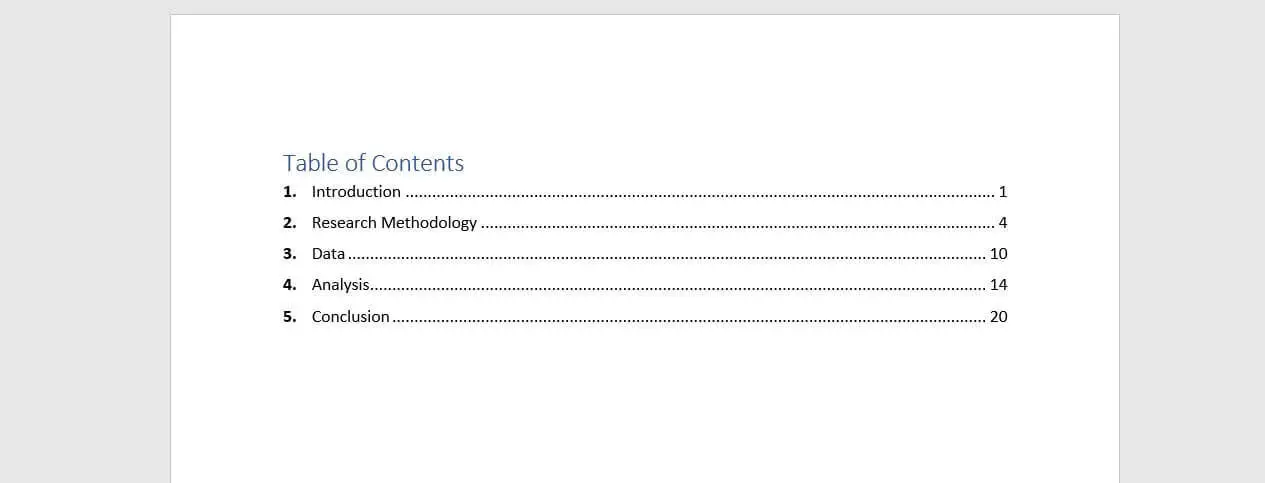
Subdivided TOC
To properly inform the reader of what each chapter of your dissertation or thesis will be covering, a subdivided table of content should list chapters and level-2 headings as well.
Example of a Subdivided Table of Content
A multi-level table of contents further subdivides divisions into “level 3” headings. With this choice, be cautious since things might rapidly get out of hand. The maximum length of the table of contents should not be more than two pages.

Multiple-level Table of Content
Example of a multiple-level table of content.
Less is frequently more in these introductory sections. Narrow it down to only the most crucial sections as you choose which ones to include.

Get your template
Looking for Dissertation Help? We are here to assist!
- Topic Suggestions
- Confidentiality
- 100% Plagiarism Free
- Qualified Writers
- Proofreading

Adding Tables and Appendices
List all the appendices in your table of contents, while the tables and figures should only be added if you have added plenty of them in your dissertation or thesis.
- If you have added more than 3-5 figures and tables to your dissertation, list them on a separate page.
- It is okay to separately list the tables and appendices in the thesis and dissertations, but they should not be listed separately in research publications.
What Should not be included in the Table of Content?
Add all level 1 and level 2 headings in your table of content, with level 3 headings being used where necessary.
Do not add the following to your table of content.
- The table of content.
- The acknowledgement page
- The abstract or exclusive summary
There is no need to include the acknowledgements and abstracts since they always come before the table of contents. Any sections that come before the table of content should not be included in it.
How to Create a Table of Content in MS Word?
Applying the appropriate heading styles consistently across the page is a requirement before Microsoft Word will automatically create a table of content for you.
Give each section a proper heading. Select the headings that are heading 1 and heading 2 or 3.
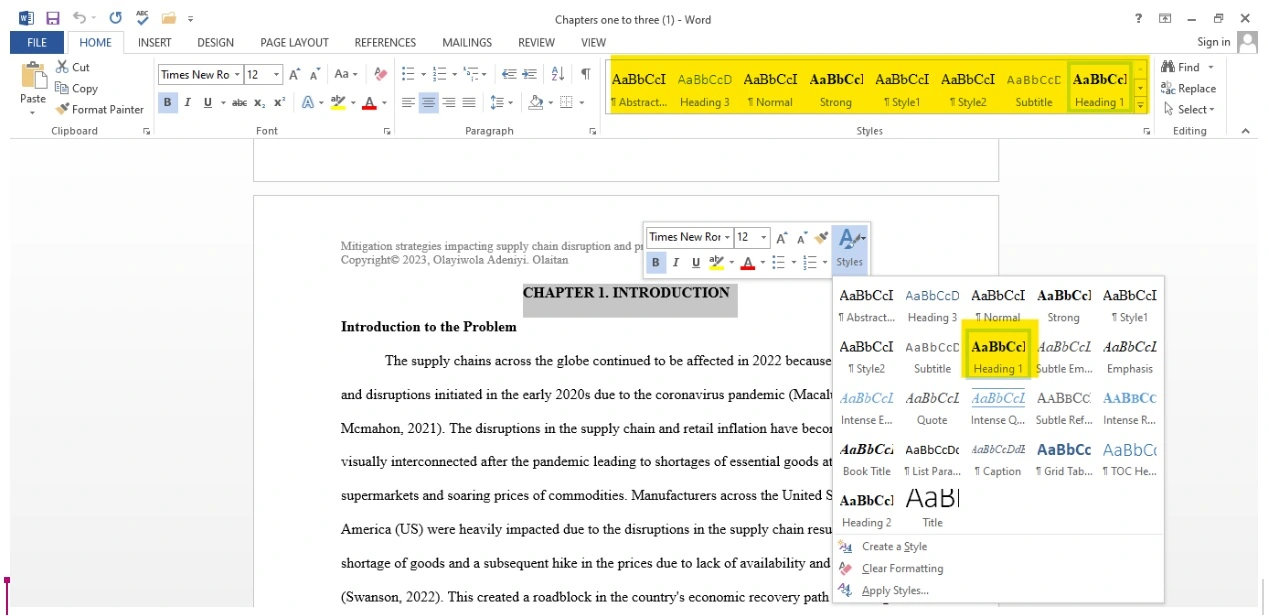
The image above demonstrates how you can set the proper headings for each section. Select the text you want to use as a heading 1 and right-click on it. Click styles from the drop-down menu to select the style, or simply choose from the options presented in the toolbar.
Add this formatting to the first level 1 heading and use the same font, size, and bold for all level 1 headings. Use the styles section on the toolbar to automatically apply this formatting to all of your level 1 headings.
- Select the 1 st heading.
- Right-click on the style labelled “Heading 1.”
- Choose “Update Heading 1 to Match Selection”
Once you have set all your level 1 headings, it’s time to set level 2 and level 3 headings. Follow the same procedure to select all level 2 and level three headings. Each heading in your document can have its formatting assigned by selecting the desired style while the heading is highlighted.
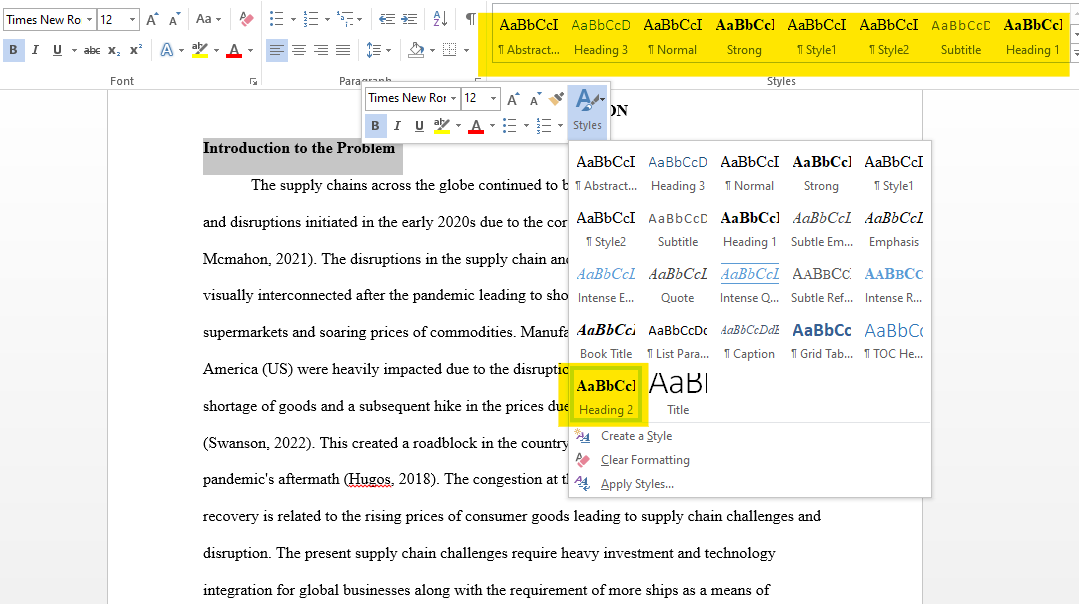
Now that we are done setting our headings, it’s time to put them in the table of content so that the reader can navigate through the wonderful thesis you have written.
Follow these simple and easy steps to automatically create the table of content, but before you do that, check to see if your university or citation style has laid any rules or guidelines regarding this.
Set your cursor where you want the table of contents to appear. (The table of contents (TOC) ought to come after the abstract and before the introduction chapter of your dissertation or thesis. )
Go to the reference section of the toolbar at the top of your word application. And then left click the table of content in the left corner.
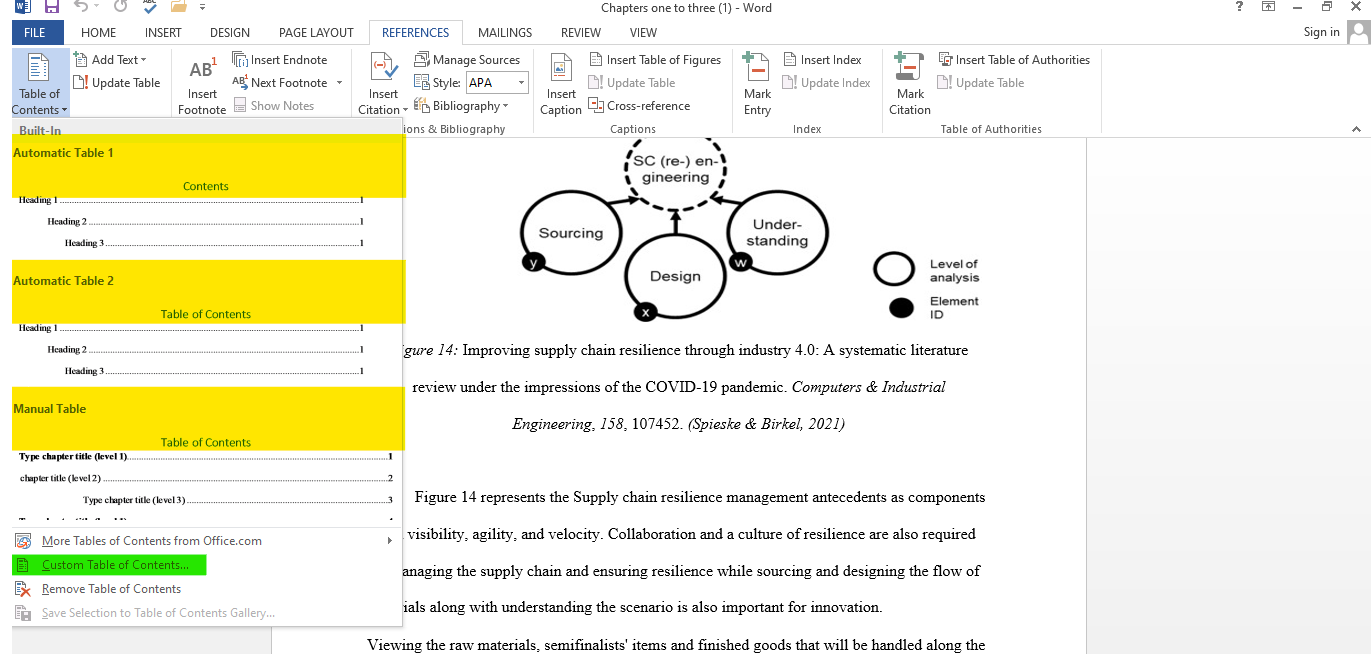
From the drop-down menu, select the appropriate format for the table of content which matches your requirements and the guidelines to create the table of content automatically. You can add more styles or custom create the table of content to fit your requirements as well on the Custom Table of Contents menu, you can choose the levels of headings you want to use. By selecting the Modify button on each level, you may also manually alter it.
When you’re ready, click “OK,” and the table of contents will be generated automatically.
Features of TOC
The table of contents main characteristics are:
- Clear headers and subheadings
- Accurate page numbers
Check with your university and the college regarding the guidelines and the rules for the table of content before you dive into it.
Frequently Asked Questions about Table of Content
What should i include in the table of content for my dissertation.
Your table of contents should include all level 1 and 2 headers. This includes the titles of your chapters as well as the key parts inside them.
All appendices and lists of tables and figures, as well as your reference list, should be included in the contents.
The acknowledgements and abstract should not be included in the table of contents.
How to create a table of content quickly and easily in Microsoft word?
- Apply header styles to the whole document.
- Go to Table of Contents in the references area of the toolbar
- Select the one which fits your requirements
Where is the correct position for the table of contents of my thesis?
Acknowledgement anf abstract is usually presented before the table of contents is added to the thesis or dissertation.
You May Also Like
A dissertation or a thesis preface is your chance to reflect on your experience during the writing. A preface is similar to reflective essay writing and mainly written in the first person.
You delve into the significance, importance, and relevance of the result in the discussion section. It should mostly be devoted to summarising and analysing your results, illustrating how they relate to your paper, dissertation, or literature review, and providing proof in support of your main thesis.
The acknowledgements page in a thesis or dissertation is positioned between the title page and the abstract. Its length should be one A4 page at maximum.
Ready to Place an Order?
USEFUL LINKS
LEARNING RESOURCES
COMPANY DETAILS

+44 (0) 141 628 7445 +44 7388 619137 8am - 8pm Monday - Friday and 10am - 4pm Saturday and Sunday.
- How It Works

Academic Report
Report generator.
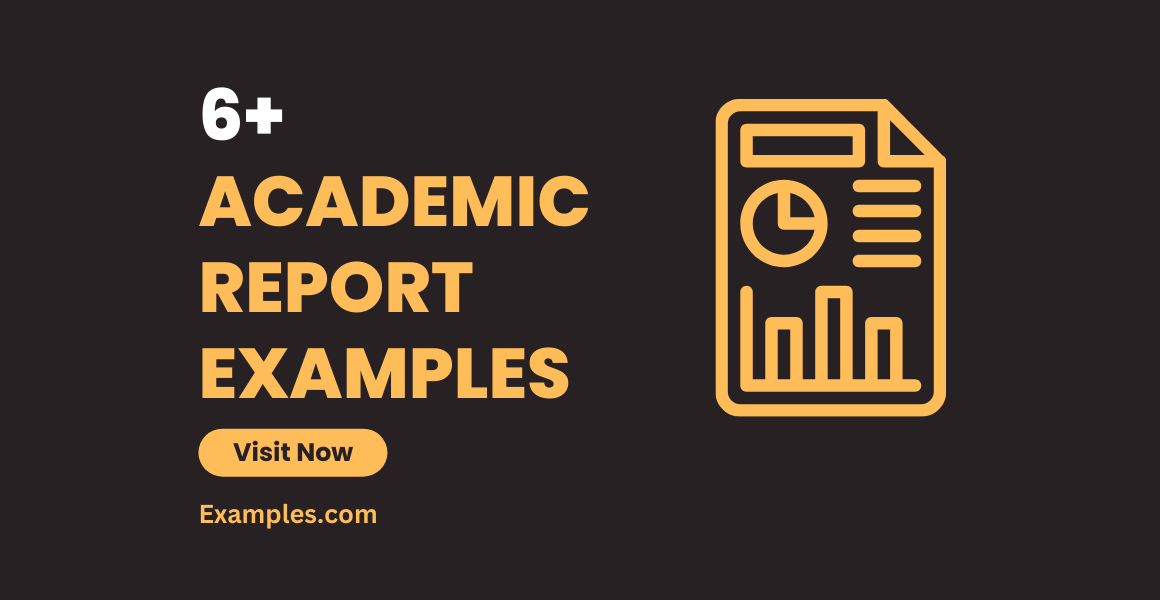
As a way of evaluating a student’s logical capacity, comprehension level and writing skill , some professors require their students to write a document presenting their ideas, thoughts, analyses, etc. about a certain topic. Other than writing an essay , the students can also use a report in order effectively present their objective deductions and findings.

A formal report is another way of presenting facts and analysis you have gathered from your readings about a certain topic. In requires thorough research, readings, rationalizing, analyzing and making a point. It goes beyond that of an essay, it is more than just arguing a position and drawing conclusions, although a report can also do that, it must comprehensively present pertinent facts and information in order for the reader to see the subject in new light.
As you may know, report writing is a very useful skill not only academically but also in your future career. Not only does it hones your writing skills it also improves your analytical and critical thinking skills since it urges you to come up with objective findings based on facts. Therefore, it will surely help you be good at whatever job you wish to pursue in the future; no employer says no to a critically and analytically adept individual. You may also see marketing report examples.
Academic Research Report Template
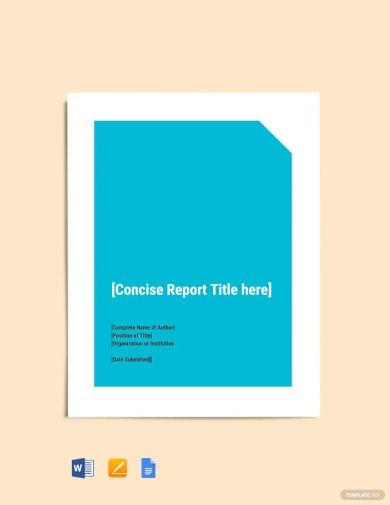
- Google Docs
- Apple Pages
Size: 31 KB
Academic Report Format Guide Example

Size: 168 KB
Difference Between an Essay and Report
An essay and a report are both effective ways of presenting information and data. However, some professors may prefer one over the other. In order to know the difference between the two, a list of their differences are presented below:
- Essay are rarely used outside the academic realm.
- It focuses on analyzing or evaluating theory, past research by other people, and ideas.
- Rarely presents the findings of a newly conducted research.
- It only has four significant parts or elements.
- The flow of writing is continuous and does not have dividing sections.
- It usually does not include table, charts, and/or diagrams.
- It should not be used as the method in arriving at conclusions.
- Is usually not reflective about the process of researching and writing the essay itself.
- It does not include recommendations.
- It is argumentative and mostly based on ideas.
- Only offers conclusions on a question or on presented issues or problems.
You may also see business report examples.
- Originated from the professional world but is still used academically.
- Often presents data and findings that the researcher himself has gathered.
- Uses data gathering methods such as surveys, experiment or case study, or by applying theory.
- Commonly has at least 12 parts or sections and 14 parts or sections at most.
- Topics are divided into different sections or headings or sub-headings.
- It usually contains tables, graphs, charts and diagrams.
- Includes the method/s the researcher used.
- It includes recommendations on what actions to make.
- It is an informative and fact-based document.
- Follows specific style for each section.
- It is written with a specific purpose and reader in mind.
You may also like examples of short report .
Management Decisions and Control Academic Report Example
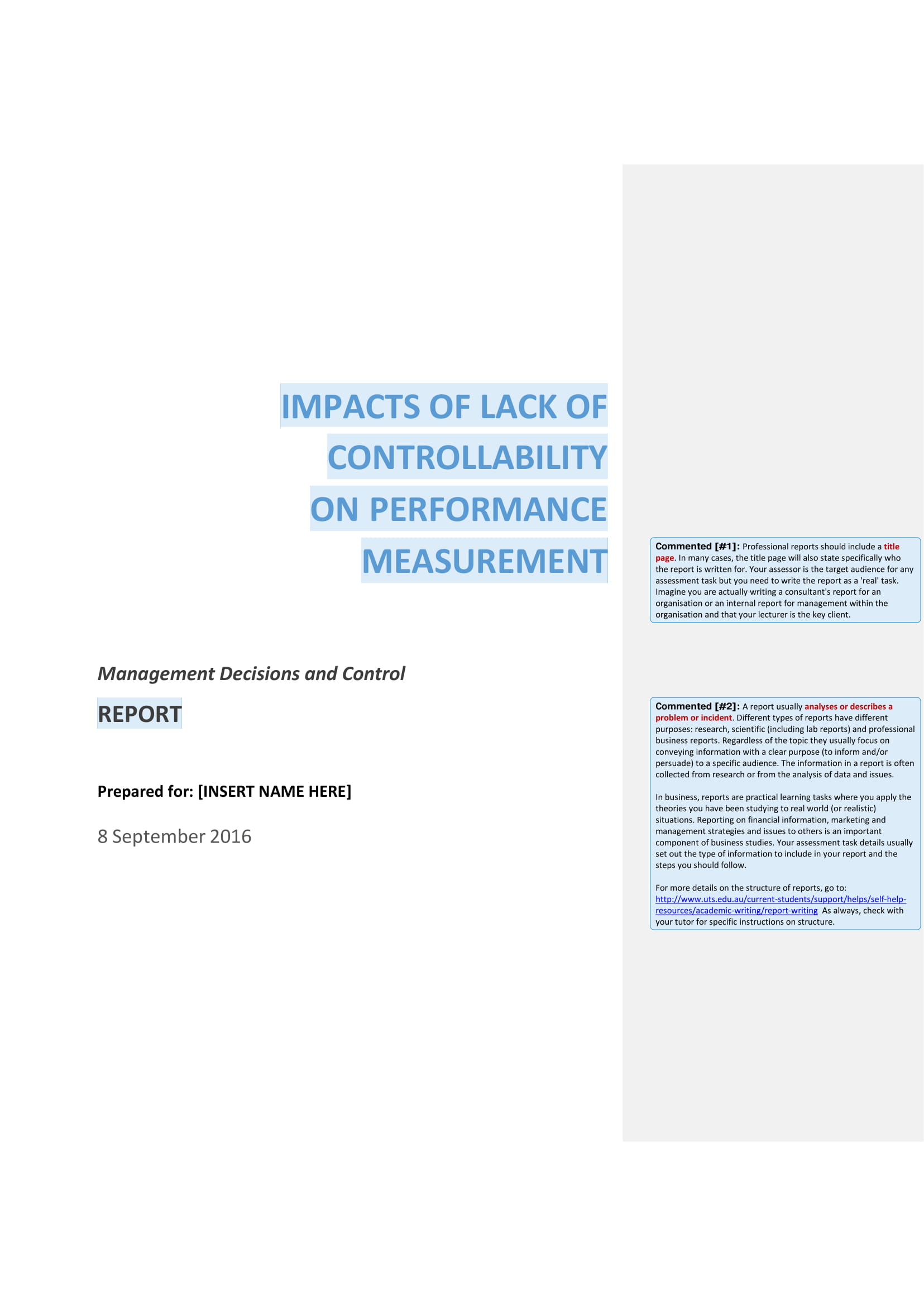
Size: 170 KB
Digital Storytelling Academic Report Example
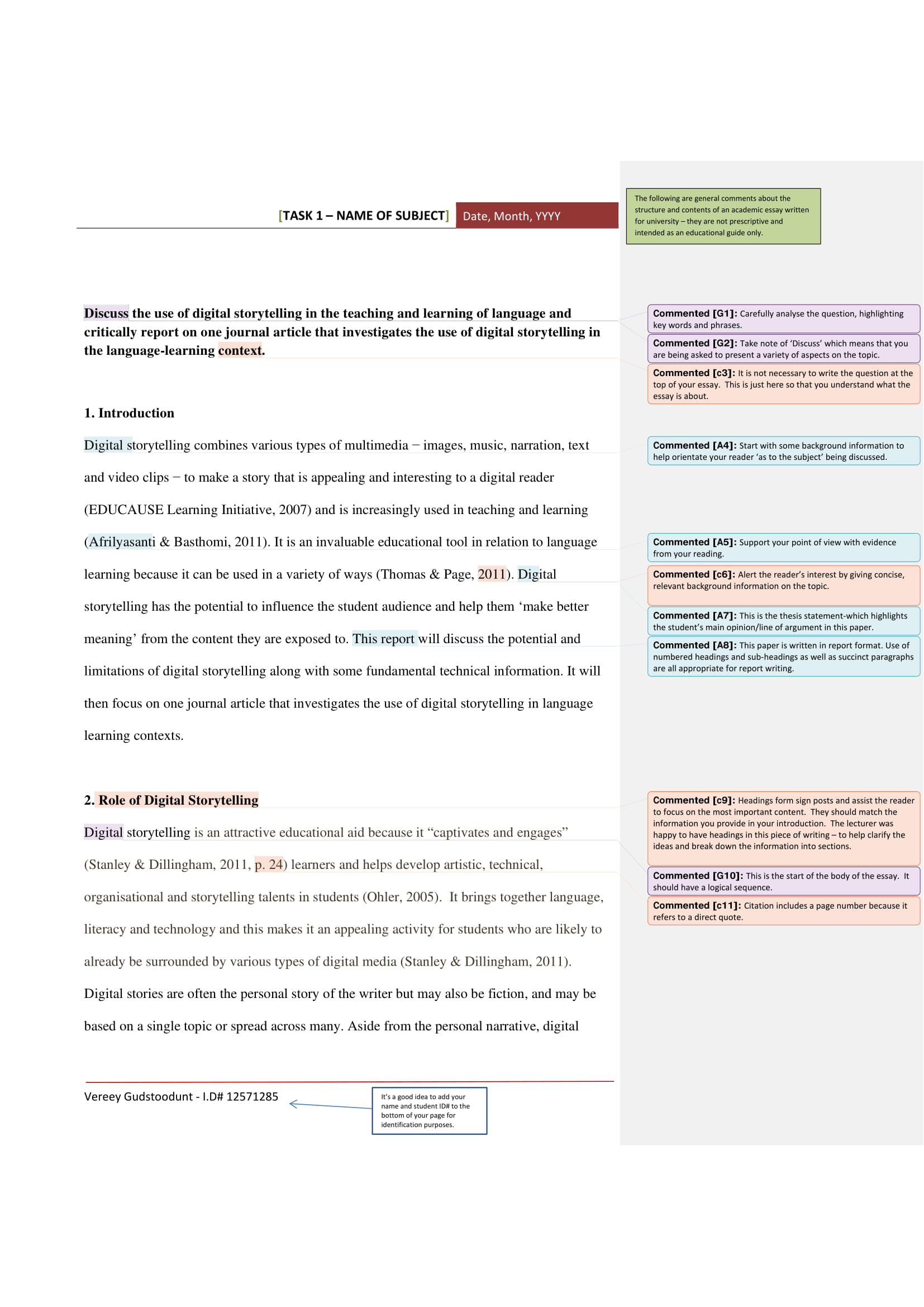
Size: 309 KB
Flood Mitigation and Water Storage Engineering Academic Report Example

Size: 201 KB
Contents of an Academic Report
An effective academic report must have the contents and sections necessary to nit-pick and through explain a subject. Listed below are the contents of an academic report:
- Author Declaration
- Abstract or Executive Summary
- Acknowledgements
- Table of Contents
- Introduction
- Literature Review
- Method or Methodology or Research Design
- Results or Findings
- Discussion of Results or Analysis or Interpretation
- Conclusions
- Recommendations
- References or Bibliography
How to Write an Academic Report
1. title page.
This means what it literally means. The title of the general report should be indicated on this page of the academic report. In some cases, the title page also includes your name as the author and student number, the name of the course and the course code. For example:
Communication Skills Relevant in International Business
John Smith (012345) Business 300
2. Author Declaration
In some universities or colleges, you will need to fill out a form from the department or faculty conforming that the report is in fact your own output. This form is attached to any assigned report or essay for your course.
3. Abstract or Executive Summary
An abstract is a short opening for your entire report. It is a basically a summary of the report as a whole and therefore should only be around 150 words in length. In order to effectively write it, a good techniques is writing it after all the sections, headings and sub-headings have been presented. Here’s a tip: write one or two sentences representing each section of the report in order to have a complete and comprehensive abstract.
4. Acknowledgements
Although acknowledgements are normally necessary in major reports, it can also be included in an academic report. This acknowledges the people who have supported you in your research and has contributed in the completion of the report. However, do not go overboard. This should only be short and direct to the point. You may also like consulting report examples.
6. Table of Contents
This is where the reader goes to look for specific sections or topics found in your report. This contains the actual titles of each section, heading and sub-headings along with their actual page numbers. A good way or organizing your table of contents is to list the contents in according to hierarchy numbers, from first to last. After the list of the contents comes a separate list for the tables, charts, diagrams, etc that is found in your report. You may also check out management report examples.
7. Introduction
The introduction must present the purpose or objective of the report and explain why the report is necessary or how it’s useful. It must immediately let the reader know that the report is useful in the field it is focused on and that it has a positive impact and recommendations on the subject at hand. In addition, you can define key terms you have repeatedly used in the report so that the reader has a clear idea on what you mean when you use the term. You might be interested in recruitment report examples.
Author’s Note : The following sections (8-11) are primarily used in major reports such as research, an experiment, survey or observation. If your report is based on reading, you can replace these sections with topic heading of your own choosing.
8. Literature Review
In this section, describe and report the previous and current thinking and research on the topic. You include a summary on what other have written about the topic you are reporting. This section will mostly consist of in-text citations from the books, articles, reports, etc. you have read about the topic. You may also see report examples in excel .
Simply, it is a review of all the literature you have read in order to form your own thinking about the topic. These literature are your basis for conducting your own report. The literature review should follow the format, MLA or APA format, you professor has required in citing your references.
9. Method or Methodology or Research Design
This section is all about the method or way you have gathered or collected your data. You present and tell your reader/s how were you able the data you have in your report. For example, you can describe the step-by-step process you did when you conducted an experiment or write a detailed description of a situation you have observed. In addition, in this section it is normal that you also have to explain why you collected the data through that method. An normally, the justification should also be quite detailed. You can include some in-text references to research methods references to help explain and justify your choice of method(s). You may also like monthly report examples & samples.
10. Results or Findings
Simply present the results or findings of your report in this section. There is no need for discussions, analysis and explanations of the results. Oftentimes, this section includes a table to comprehensively present the findings. Aside from that, this is also where you state whether you accept or reject the hypothesis or hypotheses you have made in you report. You may also check out sample activity reports .
11. Discussion of Results or Analysis or Interpretation
This is where you present what you think about the results you have formulated in your report. You can also include comment abut your results in this section. Here are other things the discussion section can include:
- Describing and suggesting reasons for any patterns in the results, possibly including anomalies (results that don’t ‘fit in with’ the rest).
- Explaining what you found (perhaps with reference to theory). You may also see performance report examples.
- Commenting on how much your findings agree or disagree with the literature.
- Considering the accuracy and reliability of your results (and how the methods you used might have affected that accuracy).
- Considering the implications of your results – what they might mean for your practice, for example. • Discussing what further research in this area might be useful in future. You may also like investigation report samples and examples.
12. Conclusions
In the conclusions, you should summarize the key findings of your report. Remember that all the information that you include in the conclusions should have been presented before and are new information. The conclusions should effectively summarize and present all the major points you have made so far in you report.
13. Recommendations
Recommendations are not necessarily needed in all academic reports, however, work-related and case studies should always present recommendations. These suggestions are for future actions in order to solve or improve issues or problems presented in the report. You may also check out free report examples & samples.
14. References or Bibliography
There should be a list on all the references you have used to cite and to back your claims. It should only contain all the literature you have cited in your report. Depending on the requirement, you can follow either an MLA or APA format for citation.
15. Appendices
Appendices contains all the supplementary information is ‘stored’. This could be table of data, copies of observation forms or notes, extracts from large documents, a transcript of a recording, etc. You might be interested in technical report examples & samples.
School Program Report Example
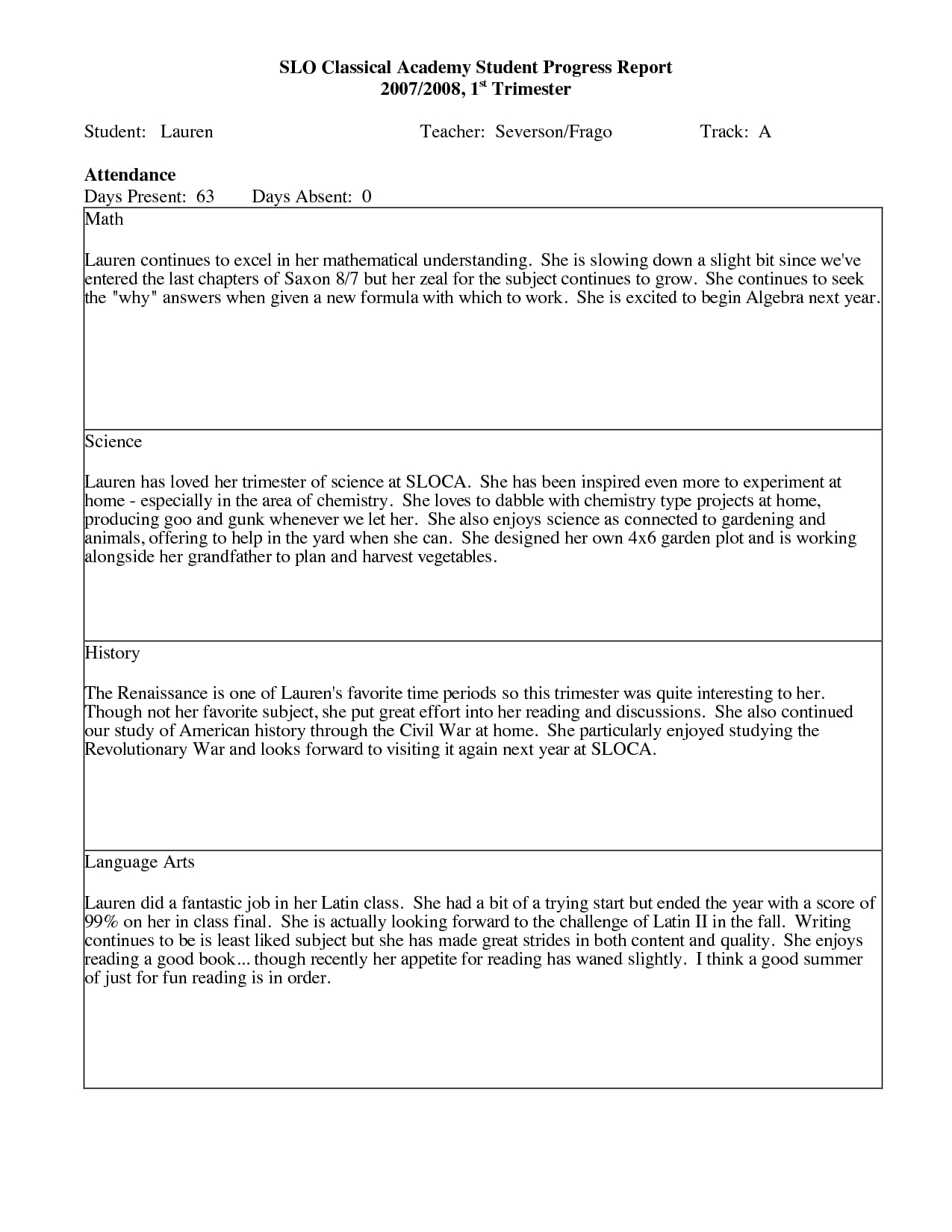
Size: 183 KB
New School Report Example
We hope you found our article on creating an academic report to be useful for your academic studies. We also included some examples which you can use as a reference/guide.
Text prompt
- Instructive
- Professional
Generate a report on the impact of technology in the classroom on student learning outcomes
Prepare a report analyzing the trends in student participation in sports and arts programs over the last five years at your school.
- Search Menu
- Sign in through your institution
- Advance articles
- Author Guidelines
- Submission Site
- Open Access
- About Radiation Protection Dosimetry
- Editorial Board
- Advertising and Corporate Services
- Journals Career Network
- Self-Archiving Policy
- Dispatch Dates
- Terms and Conditions
- Journals on Oxford Academic
- Books on Oxford Academic
Browse issues

Cover image

Volume 200, Issue 8, June 2024
Gamma ray spectrometric analysis and assessment of radiation hazards in soils of mbeere north region, kenya.
- View article
Estimation of 241 Am and 239 Pu activity embedded in the tissue using portable planar HPGe detector
Monte carlo simulation for photon energy response from the rados dosemeter, high-radiation-exposure tasks in korean pressurized heavy-water reactors, clinical diagnostic reference levels in neuroradiology based on clinical indication, a survey of the radiation safety practices of veterinary practitioners during portable equine radiography in ireland, efficacy of gonadal shielding in dose reduction for female pelvic radiography.
- Supplementary data
Simulating the head of a TrueBeam linear particle accelerator and calculating the photoneutron spectrum on the central axis of a 10-MV photon using particle and heavy-ion transport system code
Evaluation of twin fetal exposure to radiofrequency field during magnetic resonance imaging, medical staff monitoring in interventional cardiology: over apron dosemeter placement based on measurements and simulations, email alerts.
- Recommend to Your Library
Affiliations
- Online ISSN 1742-3406
- Print ISSN 0144-8420
- Copyright © 2024 Oxford University Press
- About Oxford Academic
- Publish journals with us
- University press partners
- What we publish
- New features
- Open access
- Institutional account management
- Rights and permissions
- Get help with access
- Accessibility
- Advertising
- Media enquiries
- Oxford University Press
- Oxford Languages
- University of Oxford
Oxford University Press is a department of the University of Oxford. It furthers the University's objective of excellence in research, scholarship, and education by publishing worldwide
- Copyright © 2024 Oxford University Press
- Cookie settings
- Cookie policy
- Privacy policy
- Legal notice
This Feature Is Available To Subscribers Only
Sign In or Create an Account
This PDF is available to Subscribers Only
For full access to this pdf, sign in to an existing account, or purchase an annual subscription.

IMAGES
VIDEO
COMMENTS
Generating the table of contents. Now you can generate your table of contents. First write the title "Contents" (in the style of a level 1 heading). Then place your cursor two lines below this and go to the References tab. Click on Table of Contents and select Custom Table of Contents…. In the popup window, select how many levels of ...
Place your cursor where you would like your table of contents to go. In the "References" section at the top, locate the Table of Contents group. Click the arrow next to the Table of Contents icon and select "Custom Table of Contents.". Here, you can select which levels of headings you would like to include.
Create Table of Contents in APA Formats. One more step and our APA paper with table of contents is as good as ready. From the very beginning, type the page name, keep it centered and aligned to the top. Remember about 1-inch long indents. Make the heading bold to increase readability and navigation.
Insert a table of contents: Once you've added headings to your document, you can insert a table of contents. In Microsoft Word, go to the References tab, click on Table of Contents, and choose a style from the list. The table of contents will be inserted into your document. ... Researcher, Academic Writer, Web developer. View all posts.
1. Insert the table of contents after the title page. 2. List all the sections and subsections in chronological order. 3. Paginate each section. 4. Format the table of contents according to your style guide. 5.
A table of contents is a list, usually on a page at the beginning of a piece of academic writing, which outlines the chapters or sections names with their corresponding page numbers. In addition to chapter names, it includes bullet points of the sub-chapter headings or subsection headings. It usually comes right after the title page of a ...
The basic structure of an essay always consists of an introduction, a body, and a conclusion. But for many students, the most difficult part of structuring an essay is deciding how to organize information within the body. This article provides useful templates and tips to help you outline your essay, make decisions about your structure, and ...
If applicable, indicate third-level headings under the corresponding second-level heading. Write the page number for each heading. Put the content in a two-column table. Title the page with "Table of Contents.". How to insert Table of Contents in Word (Step by Step) | Microsoft Word Tutorial: Table of content. Watch on.
Reviewing a solid table of contents example can help you understand this important feature. See examples to help you create your own table of contents.
In the 'References' section at the top, locate the Table of Contents group. Click the arrow next to the Table of Contents icon and select 'Custom Table of Contents'. Here, you can select which levels of headings you would like to include. You can also make manual adjustments to each level by clicking the Modify button.
A working table of contents should begin with a title. This title may change as you draft your text, but a working title will help you focus your thoughts as you devise the headings and plan the content for the main parts, chapters, sections and subsections that should be added beneath it. All headings, whether numbered or not, should be ...
By definition, a table of contents provides an organized listing of what is included within fictional or non-fictional works; this can consist of chapter titles, sub-chapters, sections, and sub ...
A table of contents example will help structure a long academic manuscript and a table of contents page is necessary for academic submission. The table of contents contains an organised listing of your manuscript's chapters and sections with clearly marked (and accurate) page numbers. The aim of the table of contents is to allow the reader to ...
Whether you are writing a book, large essay, dissertation, or other longer academic papers, you will have to include a table of contents. It will act as a roadmap for the reader to each portion of your writing. It helps the reader to locate specific information in a document or revisit their favorite parts easily within the text.
Throughout your paper, you need to apply the following APA format guidelines: Set page margins to 1 inch on all sides. Double-space all text, including headings. Indent the first line of every paragraph 0.5 inches. Use an accessible font (e.g., Times New Roman 12pt., Arial 11pt., or Georgia 11pt.).
CHAPTER 16: HOW TO 'STUDENT,' OR SETTING YOURSELF UP FOR SUCCESS IN COLLEGE. Coping with Workload Stress. Approaching your Professor. Form of address. Sending an email. Asking for help. Asking for letters of reference. Building a relationship. Dealing with Disappointing Feedback & Grades on Assignments.
Writing academic papers and essays in APA (American Psychological Association) format requires adherence to specific guidelines and formatting rules. ... In academic writing, the Table of Contents serves as a valuable navigational tool, guiding readers through the complex structure of a research paper or dissertation. By following the APA ...
Creating a Table of Contents in Microsoft Word. First, read over your content and make sure that each level of heading follows the APA Style guidelines. Then, on the Home tab at the top, alter the heading styles: A level 1 heading should be highlighted. Right-click the Heading 1 style and choose Update Heading 1 to Match Selection from the drop ...
Reports have a table of contents. Essays don't have a table of contents. Reports are divided into headed and numbered sections and sometimes sub-sections, using the IMRaD format(see below). Essays are not divided into sections but you may have separate headed appendices. Reports often originate from outside academic subjects and are typically ...
Multiple-level Table of Content. A multi-level table of contents further subdivides divisions into "level 3" headings. With this choice, be cautious since things might rapidly get out of hand. The maximum length of the table of contents should not be more than two pages. Example of a Multiple-level Table of Content
How to Write an Academic Report. 1. Title Page. This means what it literally means. The title of the general report should be indicated on this page of the academic report. In some cases, the title page also includes your name as the author and student number, the name of the course and the course code. For example:
Oxidation and reduction, collectively known as redox reactions, constitute fundamental concepts in general chemistry. These reactions dynamically exchange electrons during chemical transformations. In general chemistry, understanding redox reactions is pivotal, as they are a part of various chemical processes such as the corrosion of metals or ...
Revised on July 23, 2023. We have designed several free templates to help you get started on a variety of academic topics. These range from formatting your thesis or dissertation to writing a table of contents or a list of abbreviations. We also have templates for various citation styles, including APA (6 and 7), MLA, and Chicago.
table of contents: i. academic councils and committees a. councils of the senate 1. senate council 2. graduate council 3. undergraduate council 4. health care colleges council b. committees of the graduate school 1. graduate school committee on fellowships and traneeships a. bio medical sciences b. humanities
Radiation Protection Dosimetry | 200 | 8 | June 2024. Oxford University Press is a department of the University of Oxford. It furthers the University's objective of excellence in research, scholarship, and education by publishing worldwide